Things to Know Before You Visit Madagascar
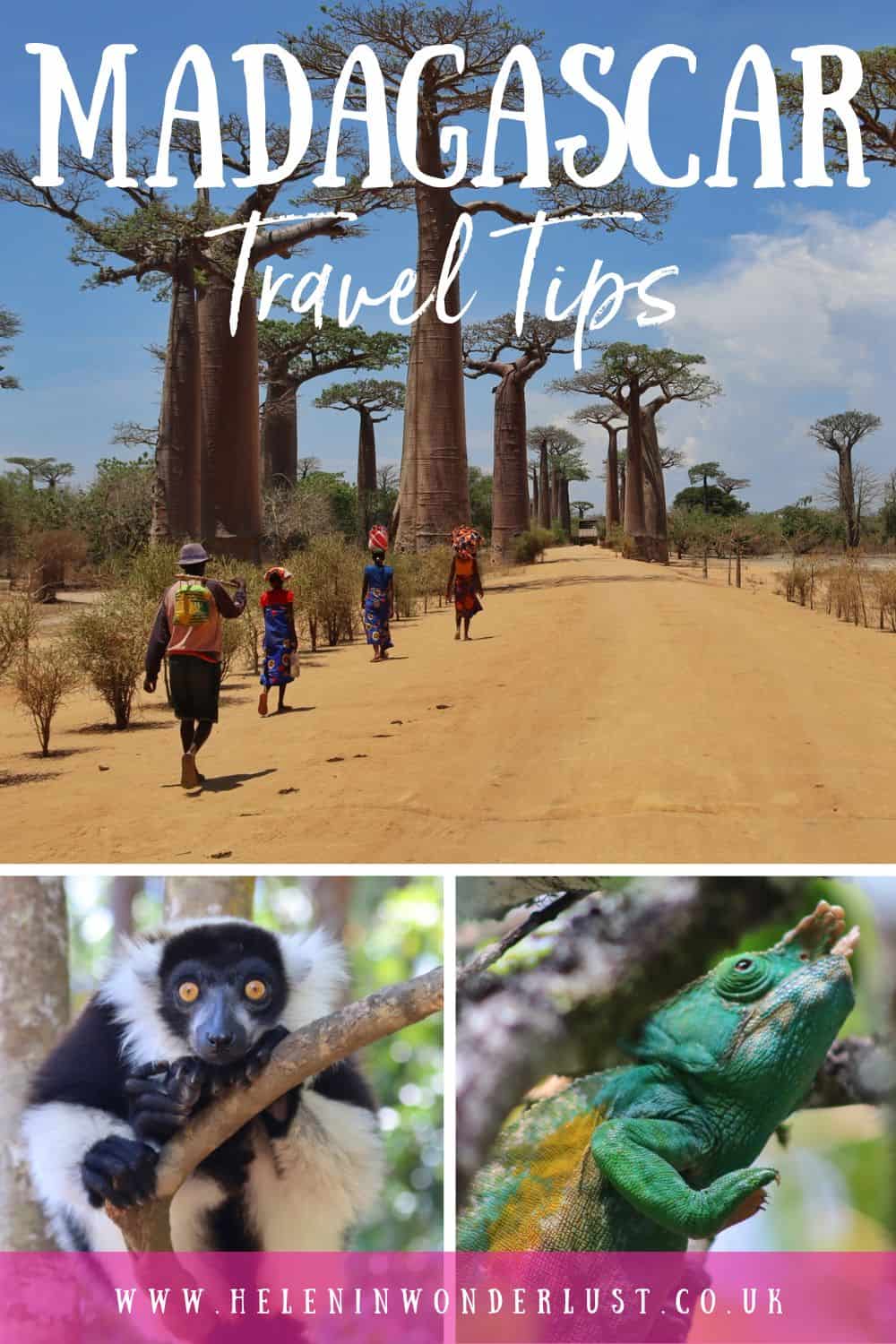
I’ve not long returned from my second trip to the incredible island of Madagascar, the 4th largest island in the world which lies off the east coast of Africa in the Indian Ocean.
It’s an incredible place to visit and the perfect place to go if you want a real adventure. You know, the type of trip you’re gonna talk about for years to come. That’s Madagascar, and after just one visit it quickly snuck into my list of the best African countries to visit!
To help you have a safe, fun, and well-informed trip, I’ve pulled together a list of practical advice and tips for travelling in Madagascar, one of the most unique and interesting places I’ve ever been.
But if you’re looking for a list of things to do in Madagascar (rather than tops for travelling there) – check out this post!
PS. Did you know that I organise Madagascar group trips? Click here for details.
Please Note: Some of the links in this post are affiliate links, which will earn me a small commission at no extra cost to you. Affiliate sales help with the running costs of this site, so thank you for your support!
Things to Know Before You Visit Madagascar
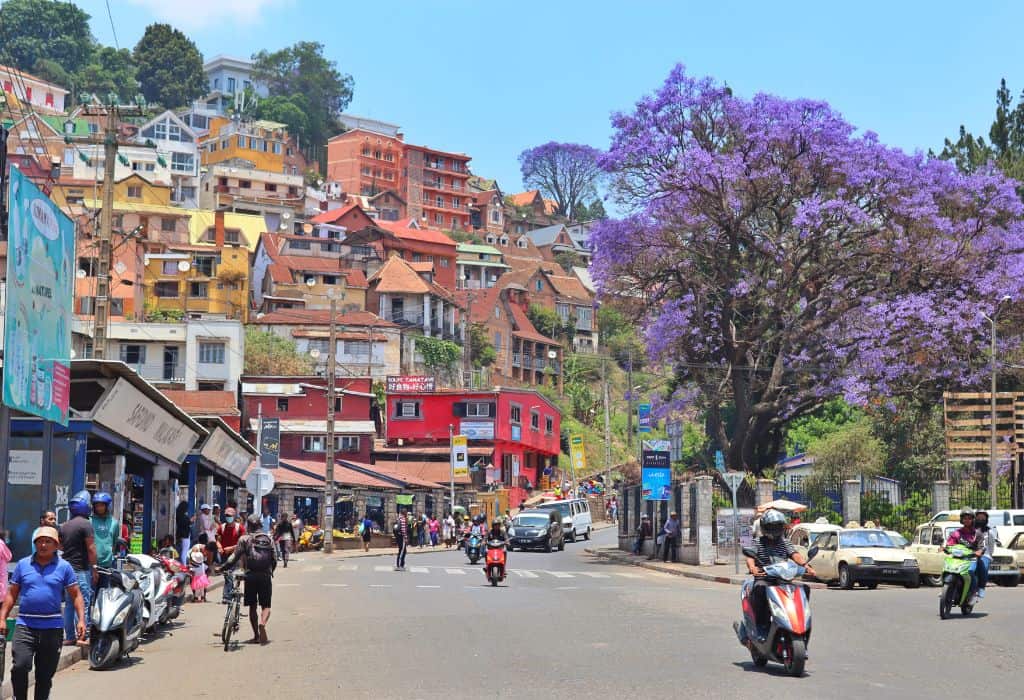
The Best Time to Visit Madagascar
So I’ve written a whole separate post on the best time to visit Madagascar, but here’s a brief rundown!
The best time to visit Madagascar, really depends on where you are going, as it’s a big old island.
But in general, the cooler, dry season runs from mid-May to October, with the peak tourist season being June to September and around Christmas. Tropical cyclones are common during the rainy season (November – April) and can affect coastal areas badly (especially in the east). The main cyclone season is February & March.
If you’re hoping to go to Tsingy De Bemaraha National Park, be aware that the road is only driveable between April and November, and Grand Tsingy (the main event) is only open from June to the beginning of November.
We went in early November and drove 12 hours to get there. When we arrived, we were told that the main road into the park was closed as the rains had come early. It was still great up there, and the journey was half the fun, but I’d suggest going no later than late October!
If you want to see the humpback whales in Toliara/Morondava, the best time on the west coast is mid-June to the end of September, with peak season being July and August. In Nosy Boraha (Île Sainte-Marie) the best time is July to September.
Or if you want to see the whale sharks up in Nosy Be, the season runs between September and December, with the main season in October and November.
October and November are good months to see the purple jacaranda trees in bloom and baby ring-tailed lemurs. We went in November and saw lots of babies (and jacarandas)! But we did have a bit of rain and even a hail storm.
Late April and early May are good if you want post-rainy season lush landscapes, and fewer tourists.
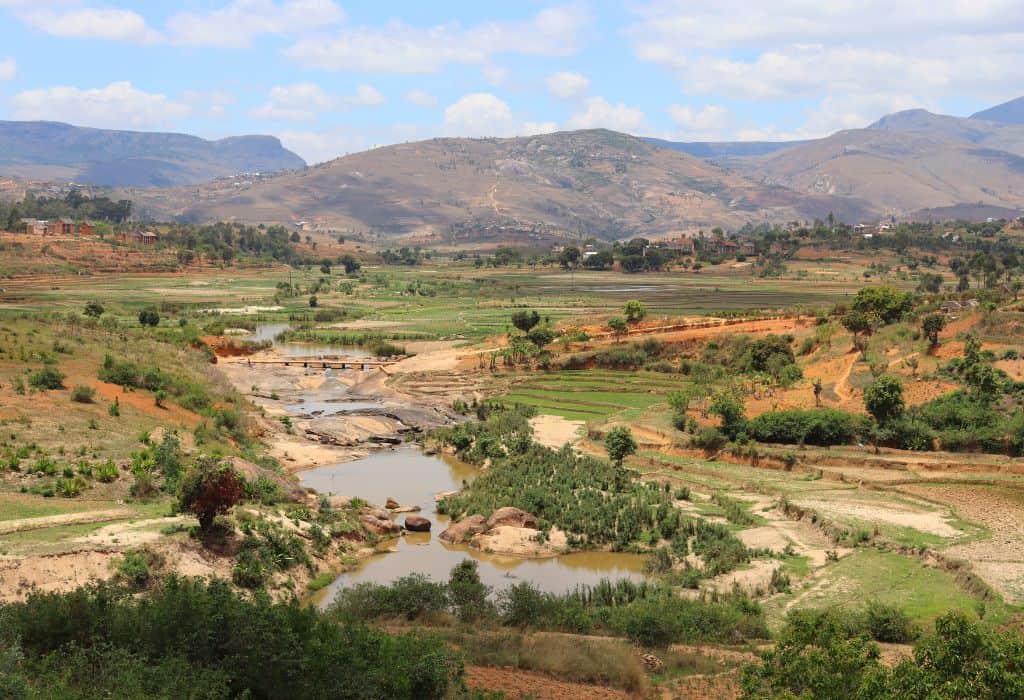
Entry Requirements
Visas
All visitors need a visa to enter Madagascar and these can be obtained on arrival… except if your passport is from Burundi or Palestine, in which case you’d need to apply in advance through an embassy.
Visas can be paid for in Euros, US Dollars, or Malagasy Ariary. There are no ATM’s before you go through customs, so you need to bring the cash with you.
Visa costs are as follows (these may be subject to change):
- 30 Days: 35 Euros / 37 USD / 115.000 MGA
- 60 Days: 40 Euros / 45 USD / 135.000 MGA
If you are visiting Madagascar for less than 15 days, you do not need a visa, but you will need to pay a €10 admin fee.
They do have an eVisa system – I haven’t used it yet, as it wasn’t working last time I visited, but you can find it here.
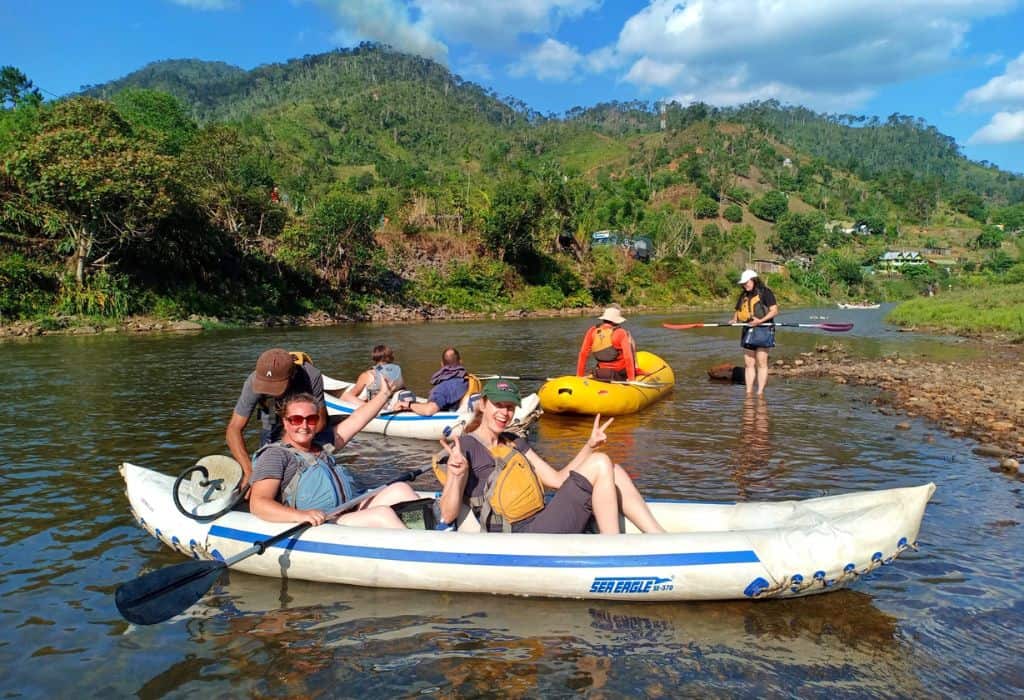
Passport
Your passport needs to be valid for at least 6 months when you arrive in Madagascar and you’ll need a couple of pages for the stamps.
It is required by law to carry your passport at all times. The police can stop you at any time and ask for it. If you don’t have it, you need to pay a small fine. For the record, they never stopped me once. But they may do, especially in the cities.
Yellow Fever Certificate
If you are coming from a country where Yellow Fever is prevalent (ie. Kenya/Ethiopia) or spending more than 12 hours in an airport of a country where Yellow Fever is prevalent, you will likely need to show your Yellow Fever card, so have it ready with your passport on arrival.
Proof of Departure
They say that you need to show proof of departure (flight details) either when you arrive for your flight to Madagascar or when you arrive in the country. I wasn’t asked for this, but just be aware that you may need it.
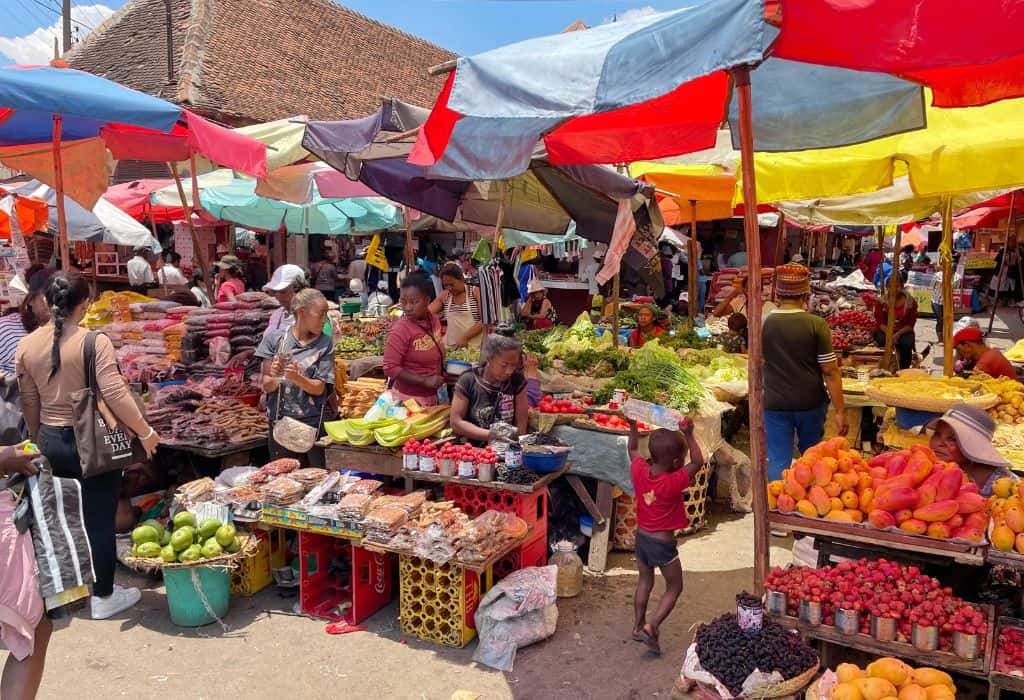
Money in Madagascar
Is Madagascar an Expensive Place to Travel?
Madagascar can be a cheap place to travel. Local transport is cheap, local food is cheap, and local accommodations are cheap.
It’s not ‘expensive’ by African standards, but if you want a slightly more comfortable experience (private driver/transport, nice hotels, tours, etc), you will pay for the privilege.
There aren’t many hostels though, so you will usually be paying for a private room in most places. But there are plenty of affordable hotels, even if travelling solo.
Internal flights are usually around $150 each, sometimes more. So they will bump up your budget a bit, but they are very convenient and much faster than driving – so it’s your choice.
International flights can also be very expensive. It sometimes costs just as much to fly from mainland Africa to Madagascar as it does from Europe (and that’s not cheap).
But in my opinion, overall, Madagascar itself is not an expensive place to travel.
The Local Currency
The local currency in Madagascar is the Malagasy Ariary. You cannot get this outside of Madagascar, so you’ll need to take money out of the ATMs or change money when you are there.
You will also be able to pay for some bigger expenses, like hotel bills, in Euros or even US Dollars. The largest Ariary note is 20,000 which is about $5.
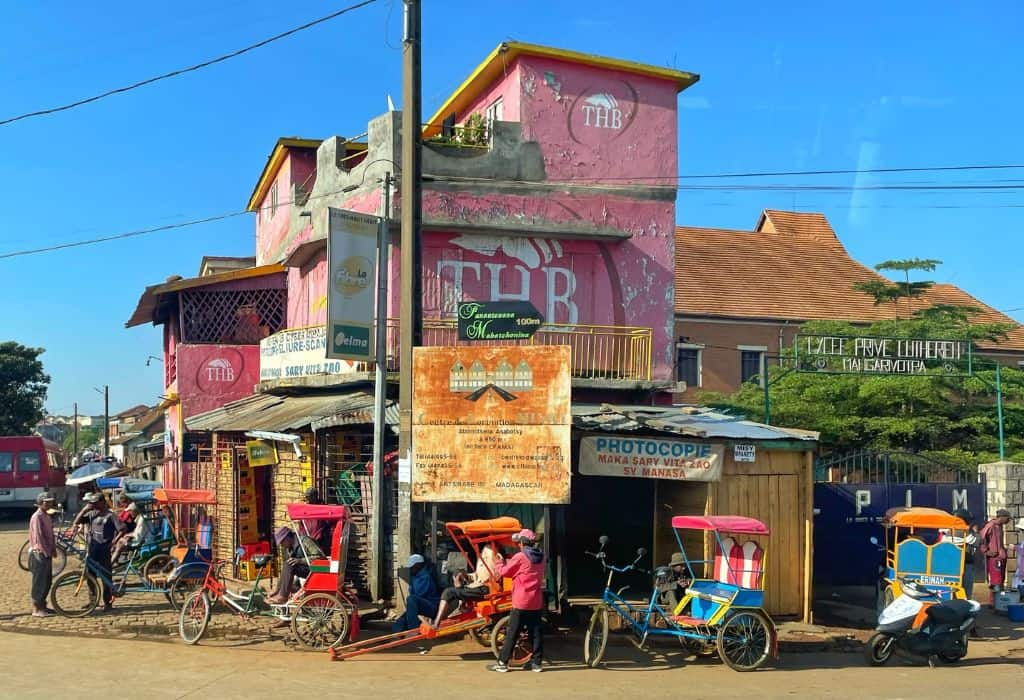
Exchanging Money
I found that the easiest currencies to exchange were Euros, followed by US Dollars.
You can also change GBP in some places, but not everywhere, and I probably wouldn’t even try to change any other currencies as I’m not sure they would be accepted.
You can change money at the airport (the rates were ok), banks, a Bureau de Change or in some shops (if you have a guide, they’ll know where to go), but the best rates we got were in our hotels. Not all hotels will be able to change money (so don’t rely on that, especially if you are somewhere remote), but most of ours did. Just bear in mind that we stayed in mid-range hotels.
The best notes to change were €100/50/20 and $100/50/20. The higher the note, the better the exchange rate. The USD notes need to be in good condition and are best dated on or after 2013 (especially any $100 bills).
If you’re changing somewhere official, you usually need to show your passport.
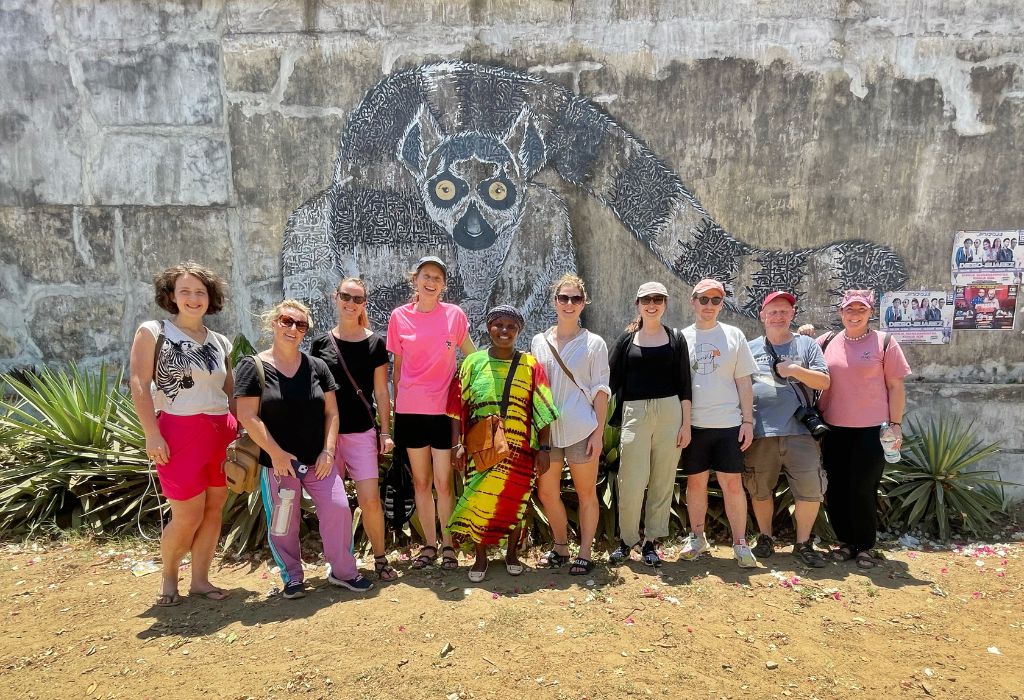
Using Your Debit & Credit Cards
Like most of Africa, Visa is generally more widely accepted than Mastercard for both paying directly and taking money out of the ATMs… but Mastercard is catching up and you will be able to use it in a lot of places! But Visa is more reliable.
I don’t think American Express is accepted in many places, so make sure you have other cards.
There are ATMs at the airport (once you go through customs and enter arrivals) and in all major towns around the country. You won’t find ATMs in more remote areas, so make sure you have the cash you need.
Getting money out can sometimes be difficult (ATMs being empty or out of order), so make sure to bring some cash with you as a backup.
The maximum amount you can usually withdraw is 400,000 Ariary.
I would suggest getting a bank card that doesn’t charge you for using foreign ATMs and don’t forget to let your bank know where you are going so they don’t block your card.
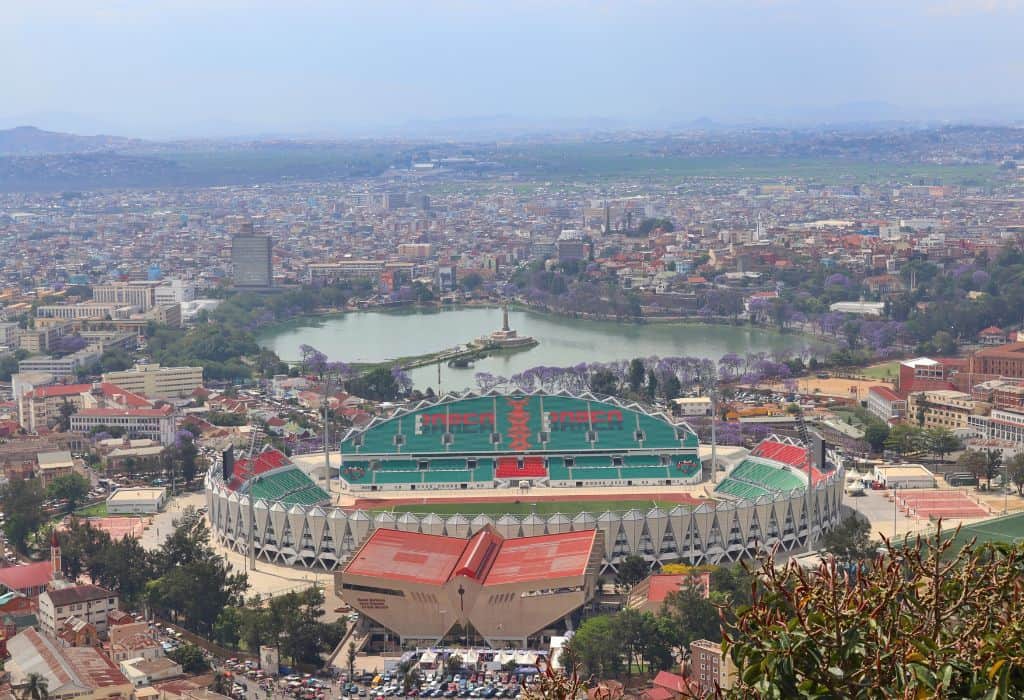
Tipping Etiquette
Tipping is always a contentious subject and everyone has a different opinion. So here’s mine…
I usually go with tipping main tour guides/drivers around 90,000 Ariary ($20), per group, per day. So if there’s a group of 4 people, you’d each put in 22,500 Ariary ($5) per day.
Then for other tips (per group), for a guide who takes you on a hike, maybe 22,000 – 45,000 Ariary ($5 – $10) depending on the level of service/length of the tour. For someone who helps you with your bags, 5,000 Ariary ($1) per bag is fine. In restaurants, a tip of 10% is good.
Most hotels also expect a tip and will have a tip box for all the staff to share. This is up to you how much you want to give. The fancier the place, the more tip you are expected to leave, as per usual.
Unless you’re tipping big amounts (ie. to a guide/driver you’ve had for multiple days), it’s best to tip in the local currency, as small amounts of Euros/USD are really difficult for local people to exchange.
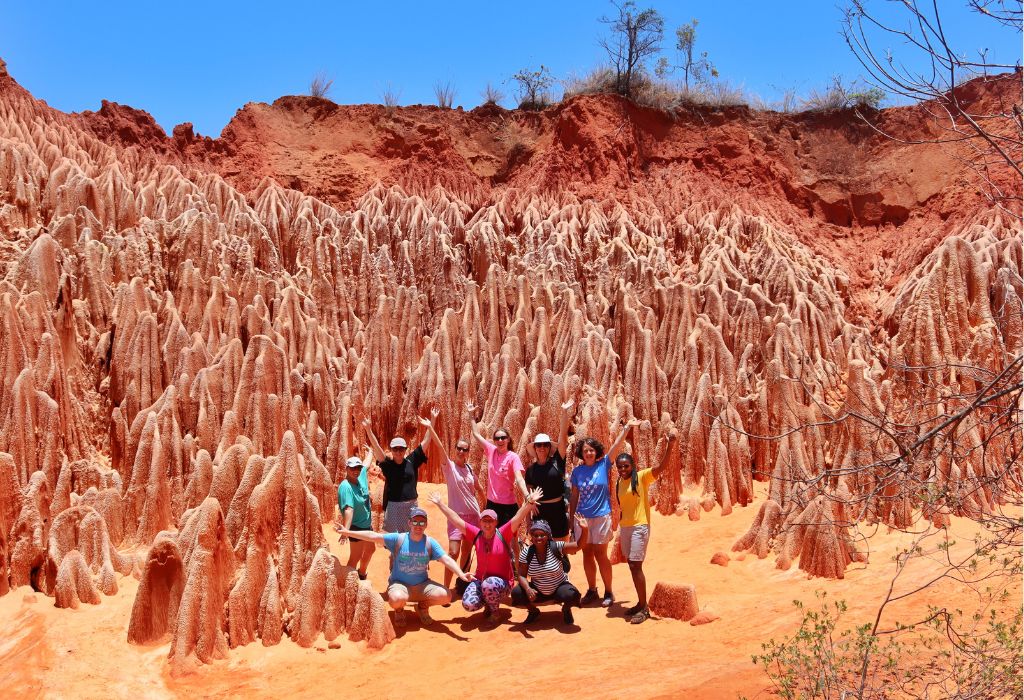
The Internet in Madagascar
Many of the hotels have WiFi, with varying degrees of speed.
The most reliable way to stay connected is to get a local SIM. The main networks are Telma, Orange and Airtel.
You can pick up a SIM card at the airport or at one of the shops in town – you will need your passport to register your SIM.
I got a Telma SIM and paid 86,000 Ariary (approx. $20) for my SIM card and 12GB of data and this lasted me for my entire 3-week trip. It didn’t work everywhere but was good enough most of the time.
You can top up your data by purchasing top-up cards around the country, either from a street stall or an official shop.
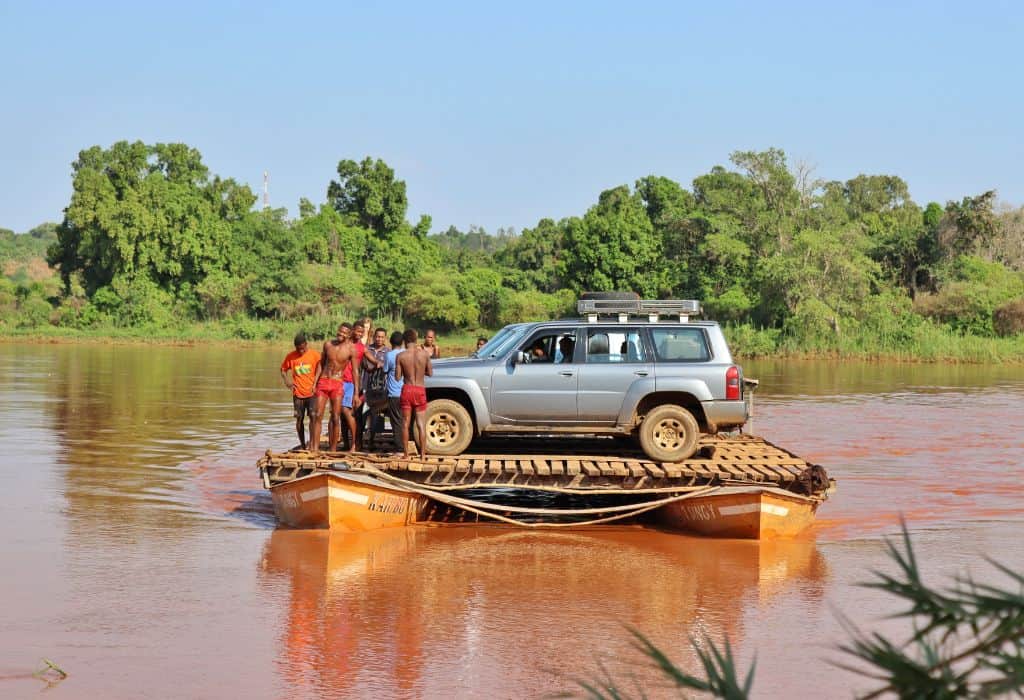
Transport To & Around Madagascar
How to Get to Madagascar
Madagascar is an island in the middle of the Indian Ocean, so the best option for getting to Madagascar is to fly.
I often see people asking about travelling to Madagascar by boat from mainland Africa in Facebook groups, but as far as I am aware, there are no passenger ferries from the mainland… which is a huge shame as that would be an awesome way to get there!
But there are some cruises that go to Madagascar, and it may be possible to bag a space on a cargo ship (from the likes of Mombasa, Dar es Salaam or Maputo) if you have time and patience, but I wouldn’t count on that as a reliable (or comfortable) way to travel!
There are 3 international airports in Madagascar offering flights from various locations including France, Ethiopia, Kenya, Reunion Island, Italy, and Mauritius.
The main airport is Ivato International Airport (TNR), just north of the capital Antananarivo (Tana for short), and this is where most international flights arrive into.
The other two international airports in Madagascar are Fascene Airport on the island of Nosy Be in the north and Amborovy Airport in Mahajanga on the northwest coast of the island.
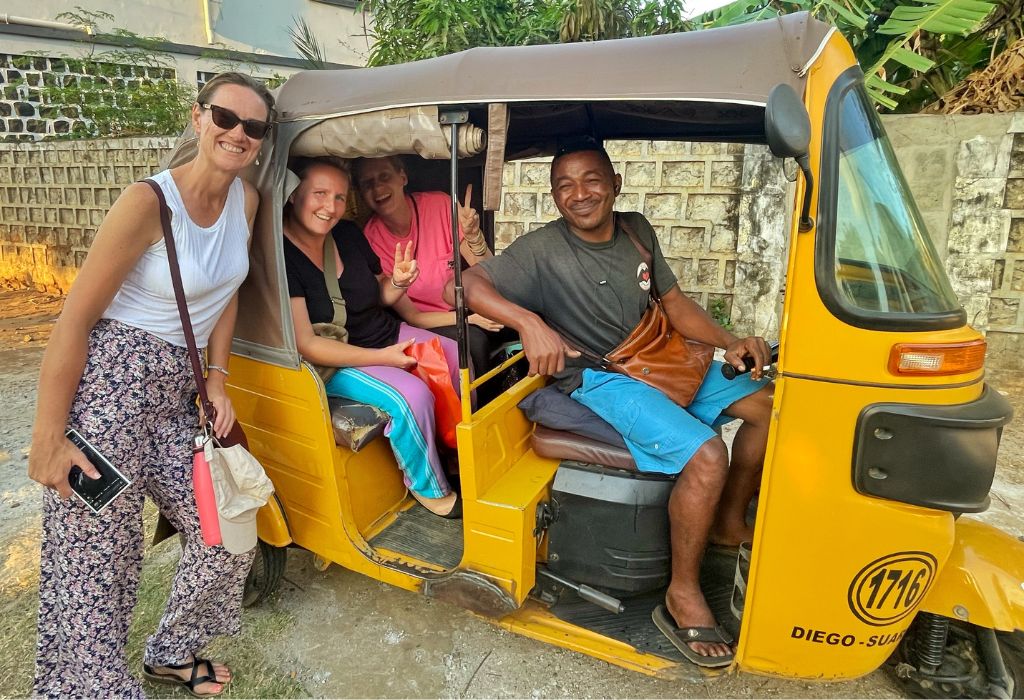
How to Get Around Madagascar By Private Transport
To easiest way to get around Madagascar, is with your own vehicle – whether that’s with a tour, hiring a driver, or driving yourself.
If you’re more of an independent traveller, you may consider hiring your own car, but just be aware that some of the roads are incredibly difficult to drive on (even for experienced Malagasy drivers) and you will need a 4×4 for some of them.
If you’re not a confident driver, I would definitely recommend taking a tour, like one of my Madagascar group tours, or hiring a private driver, especially for the more difficult parts that require driving on secondary (like the worst roads you have ever seen) roads.
You may also need to do some precarious river crossings on raft-like ferries where you have to drive up thin planks and then manoeuvre the car into position. If you’re a nervous driver, you’ll hate these! Getting on and off the ferries is an adventure in itself.
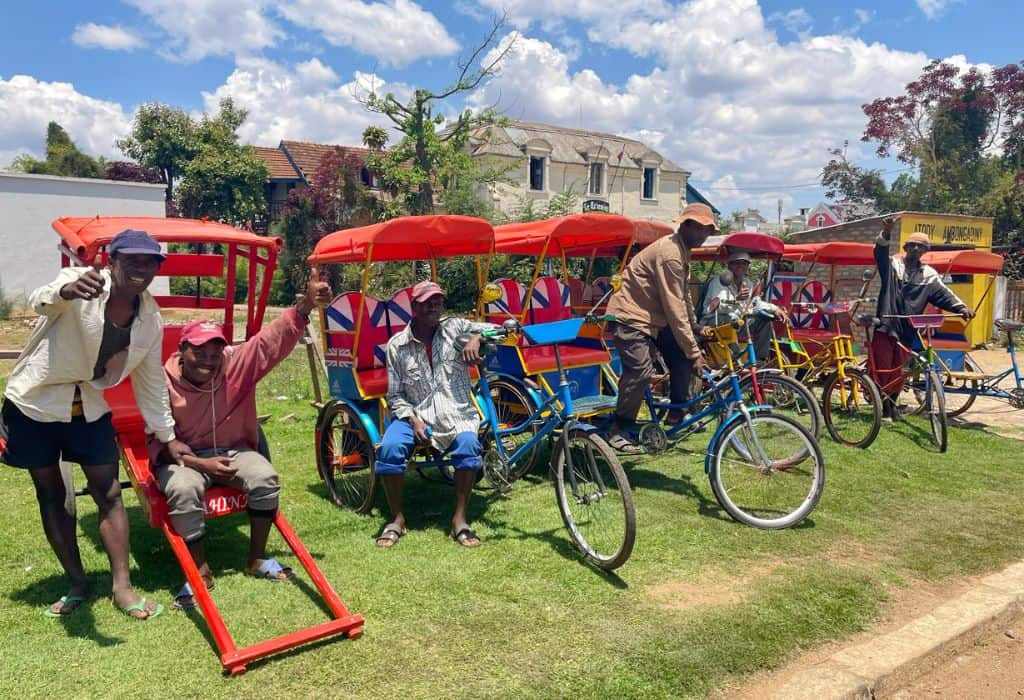
How to Get Around Madagascar By Public Transport
Within cities and towns, it’s relatively easy and cheap to get around by taxi, pousse-pousse (rickshaws either pulled by a person running or on a bike) or tuk-tuk (Bajaj).
A taxi-broussse is the general name for public transport in Madagascar. These are usually 14-seater minibusses, like you may have seen in other parts of Africa (also called bush taxis), but they can also refer to other types of public transport vehicles too.
These usually leave from the main bus station in the town and run all over the country. It’s best to check times in advance in case you need to reserve a seat, but they’ll often wait until they fill up before they leave, so they’re no good if you’re in a rush! You might wait 5 minutes or 5 hours.
But if you have the time (and patience) this is a great way to experience the local culture. They’re not always direct, they stop and start constantly (picking people up, dropping people off), they’re rarely comfortable (think packed with people, chickens, you name it), or particularly safe, but you will undoubtedly come away with a few crazy stories… and that’s what Madagascar is all about!
If you want to travel a bit more comfortably, try Cotisse Transport, they run scheduled minibusses throughout the country and have onboard WiFi. There are also some trains that run across the country, however, they can be slow and unreliable.
If you don’t want to go overland everywhere or are short on time, a good way to get around is the local airline Tsardia. I flew with them a couple of times and they were fine, but not cheap.
- By Bus: Antananarivo – Morondava = 14 hours (at least, probably more by local bus) driving and costs maybe $10
- By Plane: Antananarivo – Morondava = 1 hour flight time and costs maybe $150
There are also ferries and speedboats that go to some of the smaller islands and down the rivers too. We took the Anakao Express from Toliara to Anakao. It took us an hour by speedboat, but would have taken much (MUCH) longer by road!
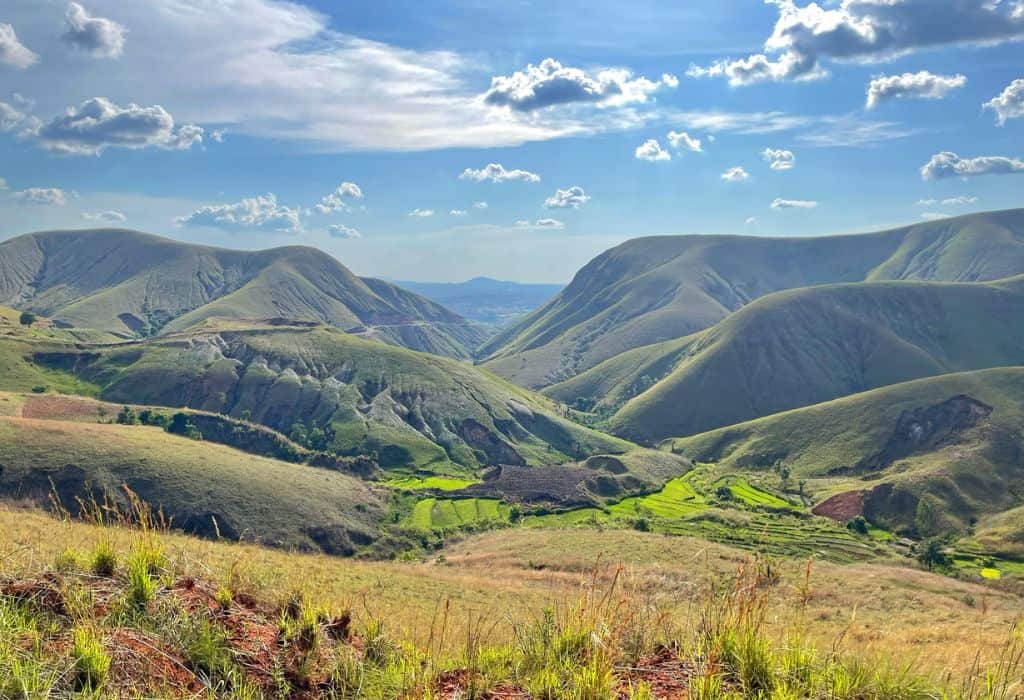
Driving at Night
I’ve mentioned it above, but some of the roads in Madagascar are TERRIBLE, so I would recommend that you only travel by daylight if possible. This is also advisable for security reasons (bandits) in some parts of the country.
I say this about most places in Africa, especially in rural areas where there a few street lights, lots of people/animals on the road, and accidents at night are common.
There may be some days when you can’t avoid it (you will always have a day or two where you end up arriving at your destination after dark due to delays), but where possible, keep your journeys relatively short and in daylight.
Travelling in Convoy
For some routes (not all), for instance, if you are travelling up to Tsingy de Bemaraha National Park, it’s best to travel in convoy.
This is good for a number of reasons, including safety (you may even need a police escort in places) and for if and when you (or someone else) break down/get stuck.
When we went to Tsingy, we travelled with a few other groups, as well as our own 5 cars. One of our cars got stuck in the mud, another group’s car had a flat tyre, another car broke down so we reshuffled and took them in and one of our cars got stuck in a river and flooded, so we reshuffled again – luckily this was only for the last few miles.
All the drivers helped each other. Had we been driving on our own or in one car, it would have been a lot more difficult, and scary.
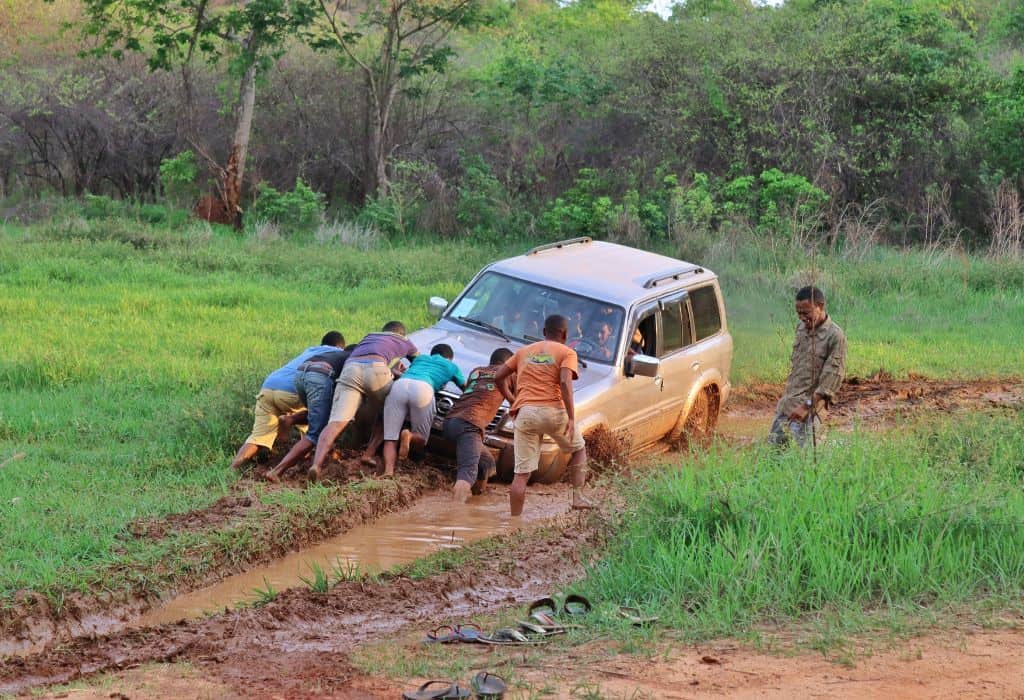
Keep a Flexible Schedule
I often talk about Africa time and how ‘relaxed’ everything is and I thought Malawi time was the worst of the lot, but ding, ding, ding, ladies and gentlemen, we have a winner. Introducing, Malagasy time!
The country’s motto is ‘mora mora’ (said ‘mura mura’) which means ‘slowly’, ‘take it easy’, or just ‘less’ (as in ‘keep the noise down’, ‘less noise’, ‘mora mora’). There is no rush in Madagascar and the sooner you get your head around the concept, the more fun you’re going to have.
It’s also rare for things to go completely to plan in Madagascar, so make sure your schedule is pretty flexible and don’t pack in too many activities. The in-between bits are just as much a highlight as the bucket list items.
Delays are common – for all the reasons I mentioned above and sometimes you get stuck on a narrow road behind someone else who’s stuck! Or things take longer because of the weather or road conditions!
We left Bekopaka super early to get back to Morondava, and heard that one of the cars behind us got stuck. Then all the cars behind that got stuck… for hours!
Getting from A to B may not always be as straightforward as it appears on Google Maps, so you really need to not be too set on particular activities or at least leave a little bit of leeway in your schedule, especially if taking public transport.
Internal flights can get cancelled or be delayed, so make sure that you give yourself an extra day in case you need to drive back (instead of fly) to Tana for your international flight.
Drive Days Are Long
You may have gathered from what I’ve said above, but you will generally spend a lot of time driving in Madagascar.
Even the good primary roads aren’t always that good. They may be tarmacked, but they are full of pot holes and twist and turn so you have to go slow and the highlights/destinations are often far apart, so there’s no avoiding some long drives. It can also take ages to get places, especially if you’re driving on secondary roads or stopping for activities along the way.
It took us 12 hours to drive the 137 km from Morondava to Bekopaka on the RN8. That would probably only take max 2 – 3 hours max on a good road, even with multiple stops! Google Maps doesn’t even recognise it as a road.
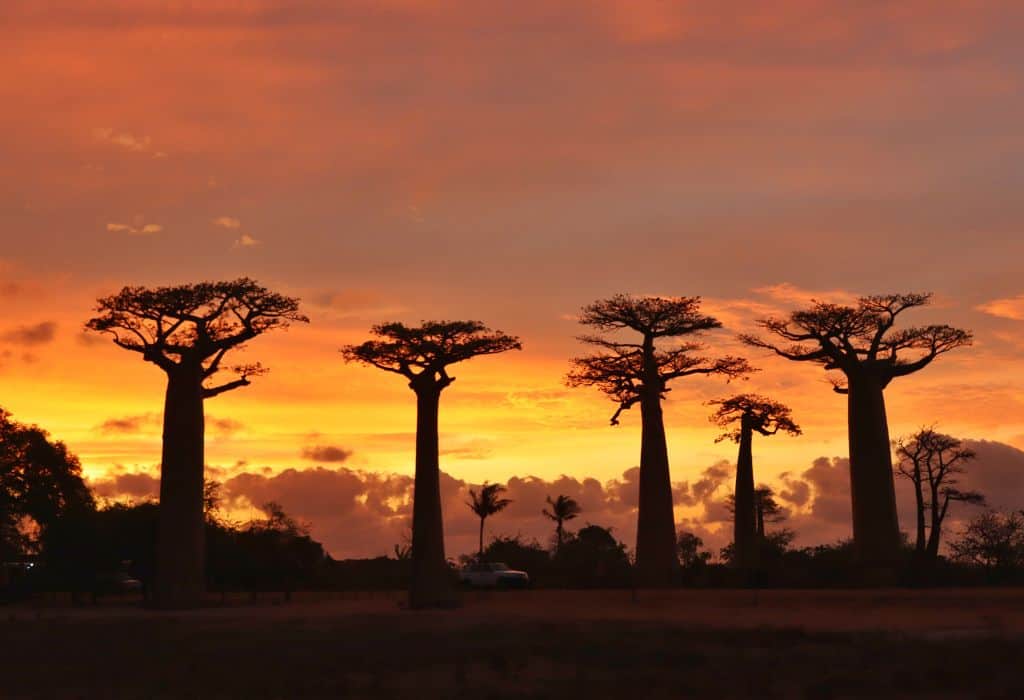
Health & Safety
Is Madagascar a Safe Place to Visit?
This is always a difficult question to answer, but here’s my personal experience. Madagascar is listed as one of the safest countries in Africa. But I have heard stories about people being mugged, having stuff stolen, being hijacked etc… so I can’t say that Madagascar is a ‘completely safe’ place to visit, but then, I could say the same about a lot of countries.
I personally had no issues in Madagascar, but I was travelling in relative luxury, on private transport, and in the safety of a biggish group. Plus, as the group leader, it’s my job to give off a confident, friendly but ‘don’t mess with me or my group’ vibe. And after years of practice, I’m very good at it.
Madagascar is one of the poorest countries in the world, so of course, there are going to be plenty of desperate people or opportunists about.
As per usual advice, remain vigilant and use your common sense. Don’t have your phone or wallet sticking out of your back pocket. Don’t leave your valuables unattended.
Try not to look too flashy. It’s fine to take your cameras to national parks etc, but leave your valuables at the hotel if you go out at night and don’t carry too much money in your purse/day bag.
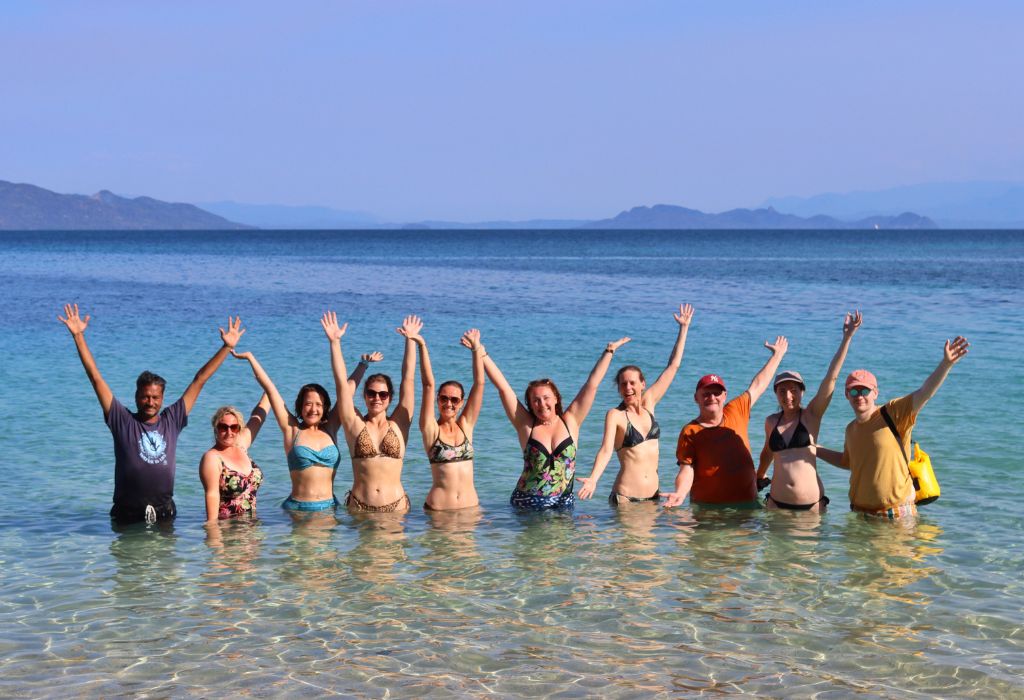
If you have a lot of money on you, make sure it’s well hidden. And maybe have a wallet with a small amount of money in that you don’t mind losing. Keep your valuables (passport, phone, money) well hidden in your bag.
If you’re in a car, don’t be on your phone by an open window. It’s very easy for someone on a motorbike to snatch it out of your hand.
Don’t walk alone at night, especially on deserted beaches or in cities, take a taxi or walk in a big group if going a short distance. If (heaven forbid) you do get robbed, don’t resist, just give them what you have.
Keep a copy of your passport/travel documents safe at the hotel, or with a friend/family member at home, in case you lose it.
Make Sure You Get Travel Insurance
Medical care across most African countries is generally not free, and payment is often required before treatment. It is essential to have comprehensive travel insurance that covers illness, injuries, and emergency medical situations. Without proof of insurance or upfront payment, you may face difficulties in accessing care.
In addition to medical coverage, ensure your travel insurance includes provisions for delays, trip curtailment (should you need to cut your trip short), theft, lost luggage, and repatriation in case of a medical emergency or another reason requiring evacuation.
It’s important to arrange travel insurance as soon as you book your flights or trip, rather than waiting until just before you leave. This ensures you’re covered in case of unforeseen circumstances that may prevent you from travelling between booking and departure.
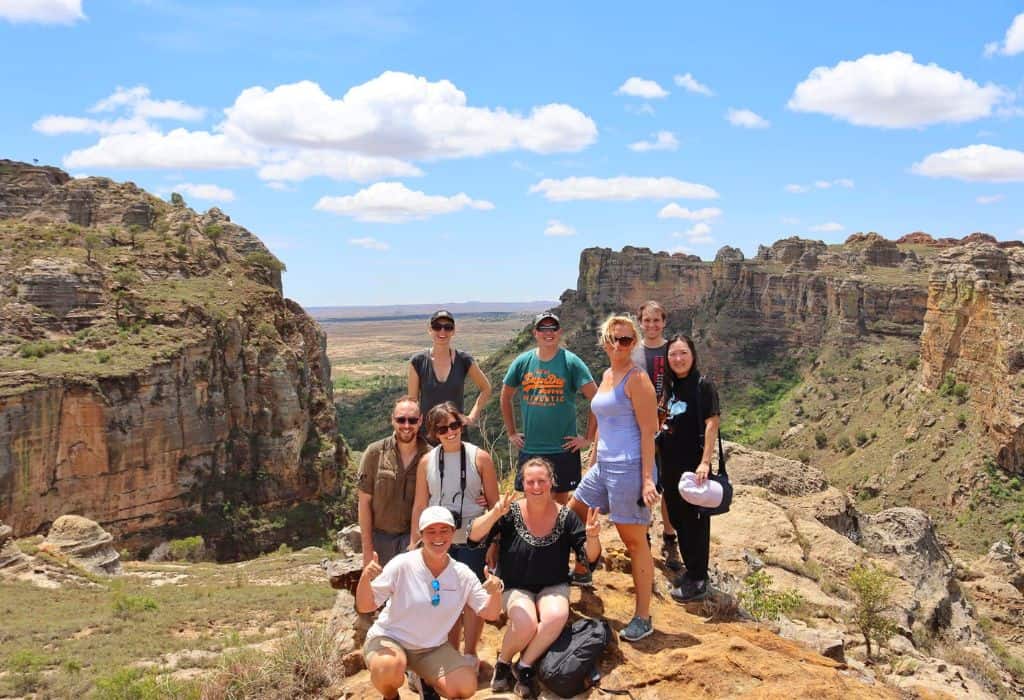
What to Pack for Madagascar
Packing for Madagascar is similar to what to pack for the rest of Africa. Clothes should be comfortable and breathable. Women should dress relatively modestly. Don’t forget to check the temperature and likelihood of rain in the season/places you are travelling.
Here are a few essentials that I would suggest you bring:
- Walking boots – you’ll do a lot of hiking through the rainforests and across the tsingys, so good sturdy shoes are essential.
- Hiking gear – quick-drying, hiking-type, or comfortable clothes are great for Madagascar to keep you cool and they’ll dry quickly if you get wet. And don’t forget some hiking socks too.
- Shorts/t-shirts – it can be hot and sweaty in Madagascar, so comfortable shorts (not too short) and t-shirts are great to have.
- Long-sleeved shirt/pants – for trekking and keeping the mosquitoes and leeches off you when trekking in the forest.
- Warm clothes – if you are travelling to the highlands, be aware that it can get pretty cold up there, especially in June/July.
- Sun hat – the sun is strong, so bring a hat.
- Swimsuit – many of the hotels have pools and you’ll definitely want to cool off in your free time.
- Rain jacket – you will likely encounter some rain during your time in Madagascar.
- Waterproof sandals – good waterproof sandals are useful for wandering around town, or light hiking. It rained when we were in Tana, the streets turned into a river and my Havaianas and Birkenstocks were pretty useless (although they were good for elsewhere).
- Pepto Bismol – for those unfortunate stomach bugs.
- Rehydration sachets – for if (and probably when) you get an upset tummy/dehydration.
- Malaria tablets – obviously this is a personal choice, but malaria is prevalent in Madagascar so it’s wise to take precautions.
- Bug spray – I recommend ones with 50% DEET.
- Sunscreen – I didn’t see much sunscreen around, so bring whatever you need with you.
- Filter water bottle – save water and the planet by investing in a filtered wattle bottle like a LifeStraw.
- Camera & zoom lens – Madagascar is very photogenic, so bring your camera. A good zoom lens (up to 300mm) is great for getting shots of lemurs in the trees.
- Silica gel pouches – one of my biggest regrets, was not bringing some of those little silica gel pouches to keep with my camera and lenses. My zoom lens fogged up whenever we were in the rainforest which made it difficult to get good pictures.
- European plug adapter – if you’re travelling from the UK, US, Southern Africa… basically anywhere other than Europe, you’ll need to bring a European plug (Type C) adapter, as that’s what they use in Madagascar.
- Headlamp/torch – power cuts are common and there are few street lights, so it’s useful to have a torch.
- Powerbank – for long journeys and power cuts. Charge it whenever you can.
- Dry bag – these are great for putting in your valuables (laptops, cameras, etc) when you travel by boat. You might also want to bring a smaller one to put your phone, some cash and your hotel key in whilst you swim.
- Waterproof bag covers – especially if you are travelling in the rainy season or if there’s a possibility your bag may end up on the roof of a bus.
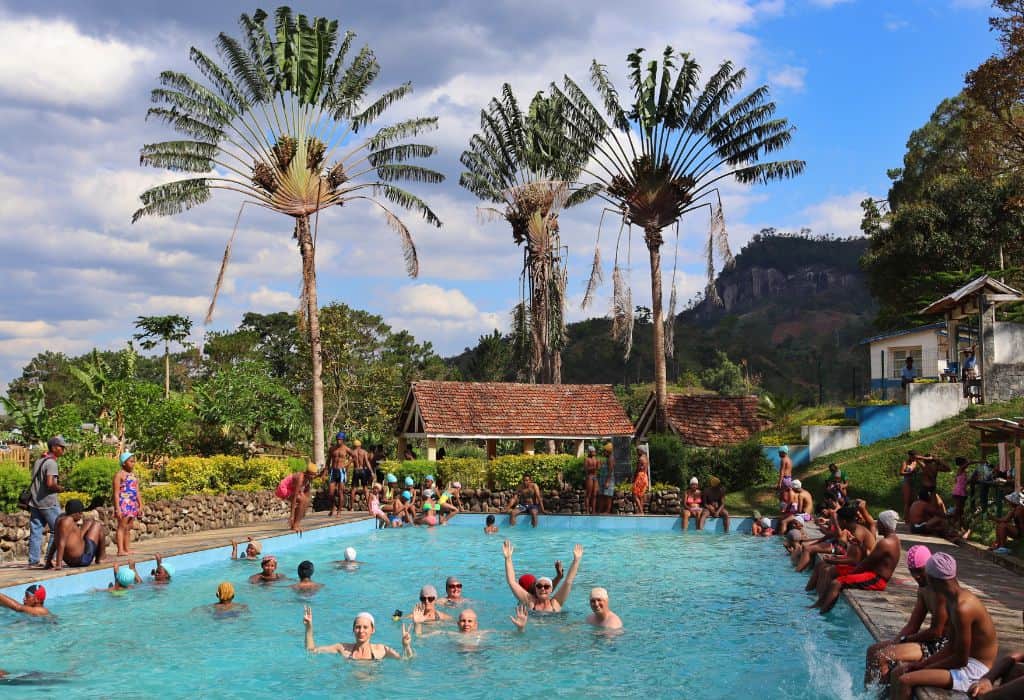
Language in Madagascar
It’s Useful to Speak French
Madagascar is a former French colony, so aside from the main local language that everyone speaks, Malagasy, and the local dialects, you will sometimes hear French spoken.
We came across quite a lot of English speakers, but there were definitely a few situations where knowing French would have made it a lot easier to communicate.
But overall, getting around as an English speaker with very crappy (‘Tout de la Fruit’ – Joey from Friends) French, wasn’t too difficult.
If I’d been completely on my own, I may have struggled a bit, but it was easier to communicate in Madagascar than in Benin & Togo in West Africa.
Learn a Couple of Malagasy Words
It’s not necessary to speak Malagasy, but I always think it’s nice to know a few words:
- Please/Excuse me – Azafady
- Thank you – Misaotra
- Hello – Manahoana (or Salama is also good)
- Goodbye – Veloma
- Goodnight – Tafandria mandry
- Have a good night – Soava mandry
- How are you? – Manao ahoana ianao?
- What’s new? – Inona vaovao?
- Cheers – Mahafaly
- Welcome – Tonga soa
- Soa – Good/nice/beautiful

Food & Drink in Madagascar
The Malagasy Food
I really enjoyed the Malagasy food. Especially the street food, which is super cheap some of the most delicious street food I’ve had in Africa – maybe tied with my beloved Zanzibar.
The staple food of Madagascar is rice. You will see many rice paddies and rice is always on the menu.
If you’re on a tour, you’ll probably eat in your hotels a lot. I try to get out to restaurants as much as possible because I love trying different foods and finding the best places to eat, but when you’re staying in remote places, there aren’t always many options.
The food in the hotels was generally very good, but it was very ‘samey’ as almost everywhere we stayed had a very similar menu – with a few changes here and there. And even when there are options (ie. small local restaurants etc) the choices may be relatively limited.
However, when visiting one of the world’s poorest countries, it’s important to be mindful of local conditions and appreciate the food options available.
On most menus, you’ll find mine sao (noodles), zebu steak (naturelle or with green pepper sauce) Cantonese rice, garden salad, and pasta with tomato sauce. And for dessert, a lot of banana flambé.
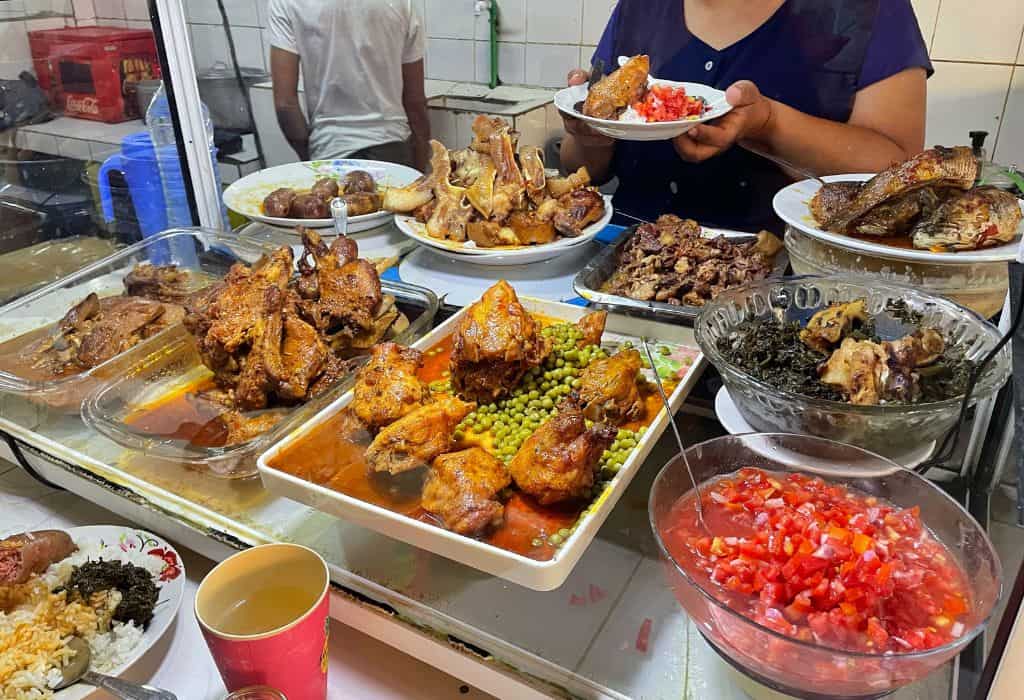
In Tana, Antsirabe, and on the coast (Morondava & Toliara) we had more variety and some great seafood. If you’re a vegetarian, you’ll probably eat a lot of pasta and tomato sauce or rice/noodles with vegetables.
The best food we had on the trip (outside of Tana) was in Morondava at Chez Maggie and at a place called L’Etoile de Mer in Toliara (Tulear). The service was very slow and I’m not sure how it took so long for the vegetable soup to arrive (we ordered 2 hours before we even arrived – it was all quite comical in the end – ‘soupe de légumes?????‘ became one of our group’s favourite catchphrases), but their crab farsi was soooo good!
In Tana, we went to some incredible restaurants, my favourites being the restaurant at Hotel Sakamanga, where some of the group stayed for the first few days (their camembert with honey and peanuts was amazing) and La Petit Brasserie (their pumpkin soup with cheese… mmm, I still dream about it now).
We also went to a great local food court at Analakely Market which had lots of local food on offer and was super cheap. We paid 5,000 Ariary ($1.10) each for chicken, rice, and vegetables.
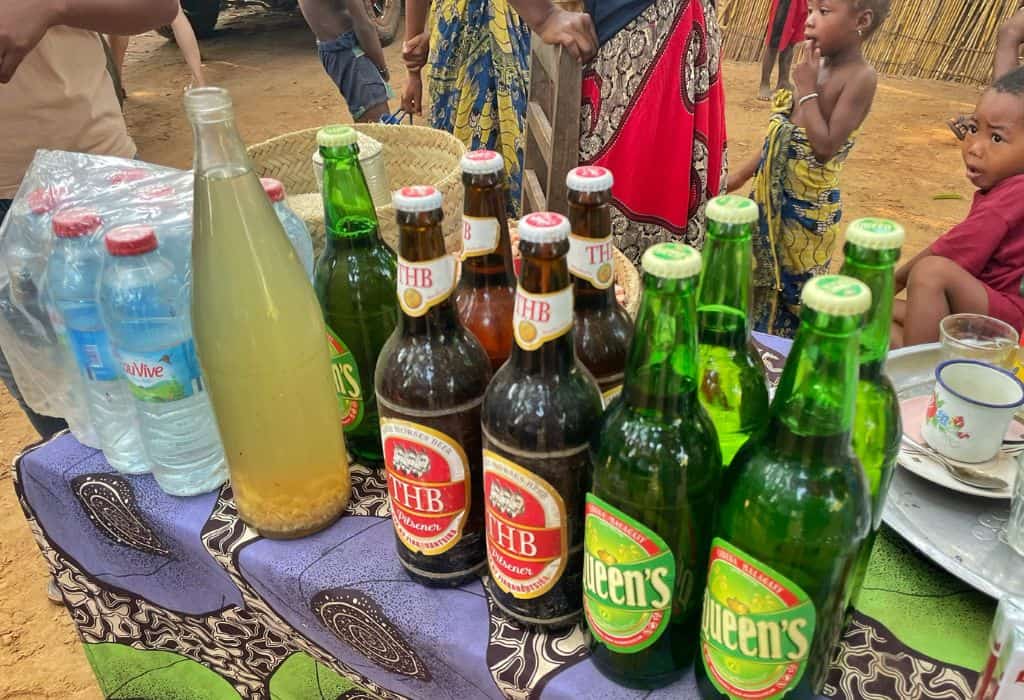
The Local Beer
The famous local beer in Madagascar is Three Horses Beer (THB), but you’ll also find others like Queen’s, Skol and Castel.
Madagascar also has some great rums! My favourite was Dzama (pronounced djama) rum, which was tasty and super cheap. You can buy it outside of Madagascar but it’s EXPENSIVE, so stock up when you are there. We had quite a lot of it one night and there were a lot of sore heads the next day.
There are also some local brews knocking about… try them at your peril! I had a shot of the local honey rum (which tasted like tequila) at 7am whilst waiting for a ferry.
Water & Soft Drinks
The water in Madagascar is generally not safe to drink, so it’s best that you don’t drink directly from the tap.
You may need to buy some bottled water to brush your teeth, but you can save money and the environment if you bring a filtered water bottle like a LifeStraw.
There are plenty of local soft drinks on offer including Bon Bon Anglais (tastes like British pear drop sweets – which makes sense given the name), however, Coca-Cola is rarely seen. I only found it twice on the whole trip – once at a posh restaurant in Tana and once at a gas station somewhere between Andasibe National Park and Tana.
Instead, they have World Cola and D’jino Cola, which just aren’t the same.
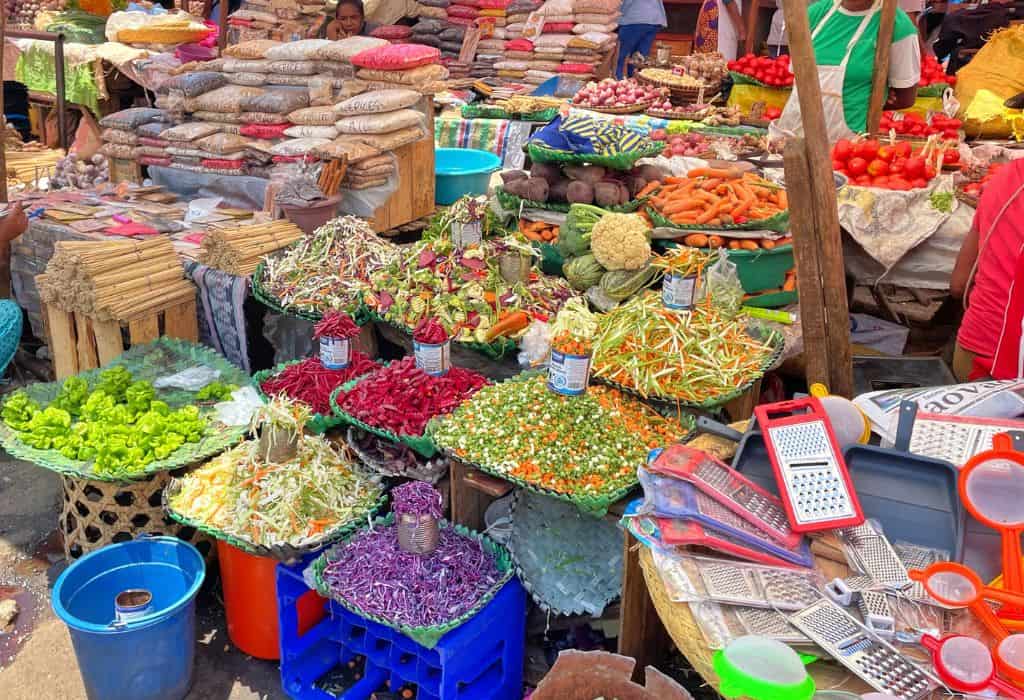
Cultural Considerations in Madagascar
It’s More Like Southeast Asia than Africa
I don’t know what I was thinking Madagascar would be like, but when I arrived I was very surprised. Driving from the airport into the capital, felt like arriving in Southeast Asia as I drove past rice paddies, street food stalls, and tuk-tuks.
But there is definitely a strong sense of Africa there too and I often thought that if Africa and Southeast Asia had a baby, it would be Madagascar.
Malagasy culture is made up of many subcultures and tribes, each with its own customs and traditions, mostly originating from Indonesia and East/Southern African settlers, who have blended together to make one of the most unique and interesting cultures in the world.
I found that the highlands felt more like being in Southeast Asia. Whereas towards the west coast, the feel was distinctly more African.
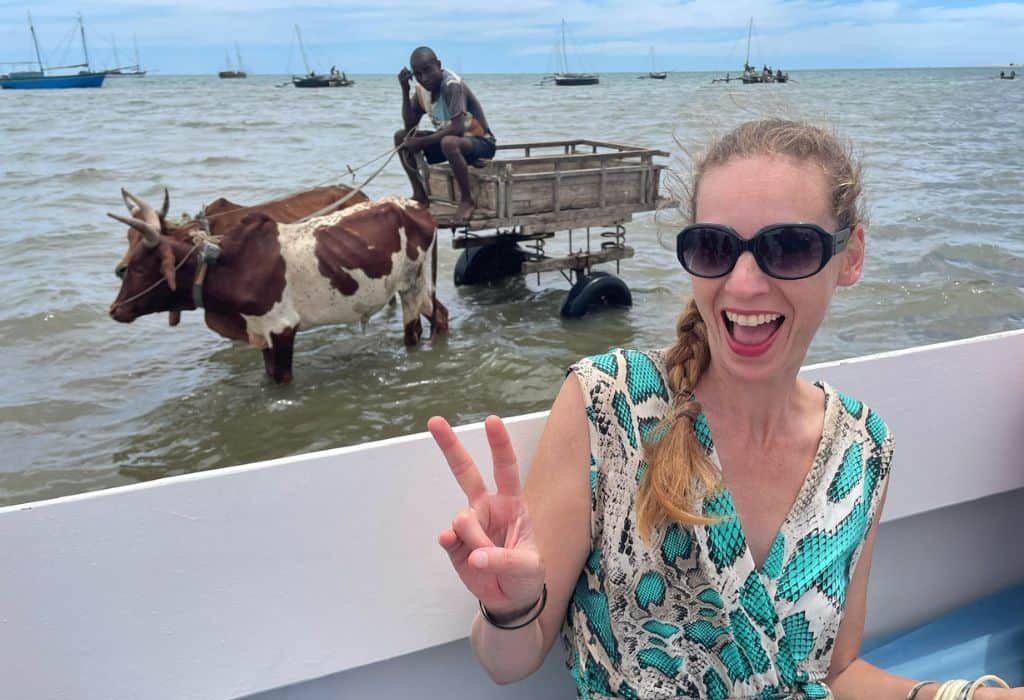
Zebus are Sacred
In Madagascar, you will find a type of humped cow called the zebu.
Zebus are everywhere and they are integral to the Malagasy way of life, both for transport and food (milk and meat). You will find zebu steak on most menus, however, they are generally only eaten by the Malagasy on special occasions.
Zebus are also a symbol of wealth and status and there is a tribe called the Bara tribe who pride themselves on being incredible zebu thieves.
Be Mindful of Fady
There are certain beliefs – superstitions that lead to taboos if you will – in Malagasy culture called ‘fady’. Some are passed down through the generations, some are newer, and these fady can be very powerful, in both good and bad ways.
Fady can be particular to a specific tribe, family, or person and relate to people, events, animals, plants, or actions.
If you break the Fady, you will upset the spirits/ancestors, which means something bad will happen, so you will have to carry out certain rituals to break the curse or be shunned from society.
Some examples include:
- You can’t kill an Indri lemur as people believe that the spirits of the ancestors live on in these lemurs.
- Some tribes believe that the endangered aye-aye (another type of lemur) and the Madagascan owl are evil spirits that bring death, illness, or crop failure and hunt them.
- The Betsileo tribe can’t eat sheep.
- Touching or moving some chameleons is forbidden.
- Pregnant women can’t eat brains.
- It is forbidden to cut down certain sacred forests.
- Funerals or farming are not allowed on certain days of the week.
- The Antambahoaka tribe in Mananjary traditionally believes that twins are fady and need to be killed or abandoned. These days, mothers of twins will now usually give one or both of the babies to a local church-run charity, or move to another part of the country, to avoid bringing a curse onto them and their families.
- You can’t point at a tomb.
- It’s forbidden to hunt or eat the tolo bird as they helped protect the Malagasy people from the French soldiers, by making a human-like sound and diverting the French soldiers away from hiding villagers.
The word for please or excuse me, as you see above, is ‘azafady’, which literally means ‘may it not be fady to me’.
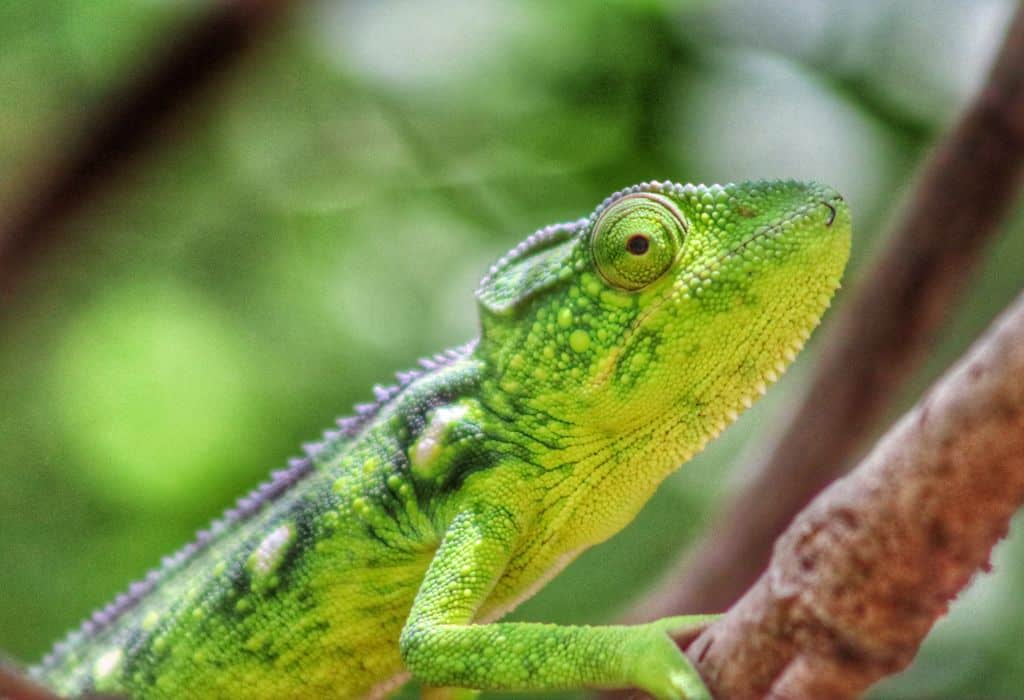
Poverty & Begging in Madagascar
Madagascar is one of the poorest countries in the world and this is very evident when you travel there.
Walking down the street, you will often be followed and asked for money or food by both adults and groups of children. It’s heartbreaking and overwhelming and despite having travelled all over Africa, I’ve not seen begging to this scale before.
So what do you do?
This is a really tough one. The official line is to never give to beggars, and as a rule, I don’t. It’s generally better to give money or supplies through a registered agency, as giving money to beggars perpetuates stereotypes and encourages more begging.
But there were occasions when I did give something, when someone was either very old or disabled, as you know that there is no other way that they can earn money. There is little to no support for people who cannot work for themselves and/or don’t have family to take care of them.
One night, in Toliara, we sat outside at a local bar/restaurant watching two musicians play. We were the only Westerners there. Within minutes 3 hungry children appeared, pleading with us, especially for food, palms outstretched ‘Madame, mange, madame, mange.’
It was very hard to ignore. We ended up buying 3 plates of mine sao (noodles) for them. By the time the food arrived, more kids had arrived. The waitress cleared a table for them, and around 8 kids sat down and shared noodles (very nicely as well – no fighting over it). They thanked us when they left.
I’ve never seen kids so grateful for anything in their lives.
Another time, I was waiting for one of my group outside a shop when a group of young girls (no older than 10) came up to me. They were all dirty, dressed in rags, obviously malnourished and each had a baby on her back. After a few minutes, I gave in. Went inside the shop, bought some bread and sachets of baby food, and divided them equally between the girls.
Was I right to do that? I don’t know. I’m not trying to be a white saviour, just a human being, and it’s really hard to say no when it’s very obvious that children, especially, are starving.
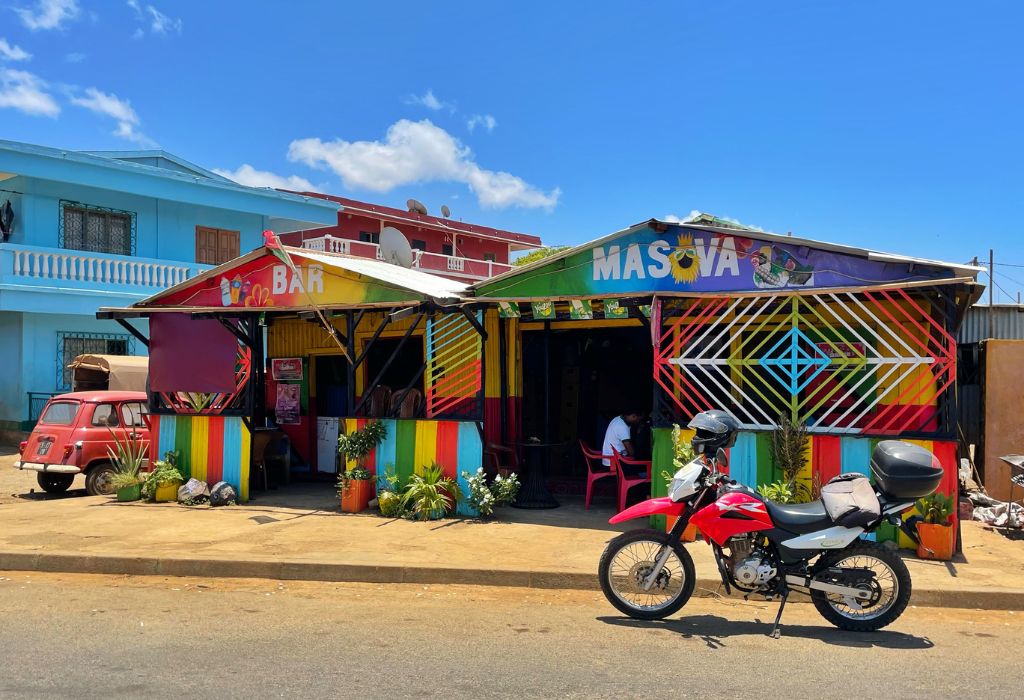
Don’t Feed the Street Dogs
This brings me to my next point. I’m told that it’s very offensive to feed dogs your leftover food because people are left wondering why you didn’t feed them and their families instead.
Try to Be Patient
Madagascar can be a frustrating place to travel, but getting irate is never the solution to any problem.
For instance, like everything else in Madagascar, the restaurant service can be a little ‘relaxed’, so don’t be surprised if your starter arrives after your main, or if you’re in a big group, you’re getting your starter when everyone else has finished.
It can be frustrating, especially when you’re getting hangry. Instead of getting annoyed at your waiter/waitress (or tour leader), check on the food and be firm, but keep calm and take it as part of the experience and remember how privileged you are. Your food will arrive… eventually.
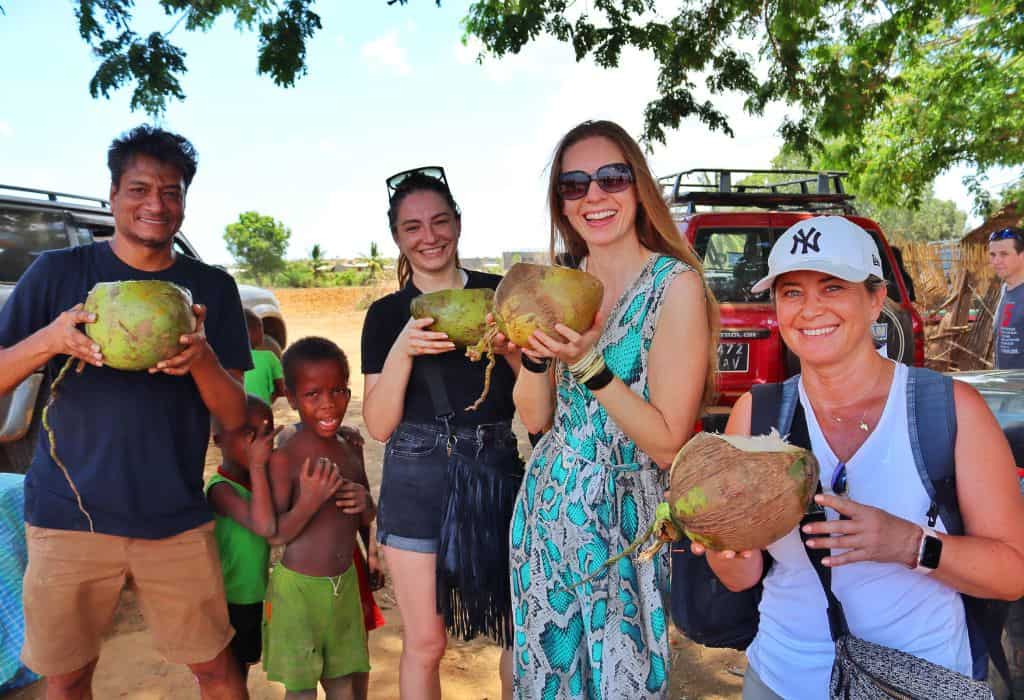
Be Aware of the Baggage Handlers
Whenever you arrive at any hotel, there will be a group of porters who will scoop up your bags before you’ve even had chance to open the car door. This provides a lot of people with needed income and they are generally happy with whatever you give them (see tipping above).
However, at the airport, these porters are quite pushy. When I arrived, I carried my own bag to the taxi. As I was about to lift it into the boot, a guy appeared and went to lift it in. I assumed he was with the taxi driver until he turned to me and went “He’s not with me”.
So I told the guy that I was ok to put the bag in the car myself, which I did. When I got in the car, he pressed his face up against the window asking for money.
One of my group also got majorly harrassed by the porters when he arrived at the airport to travel home. They followed him around and even tried to make him go to the ATM to get cash out for them. Some will even get annoyed and say you didn’t give them enough money and will try for $5 – $10.
If you decide you do want help, $1 – $2 per bag is still fine. It’s important not to encourage. unnecessary inflation.
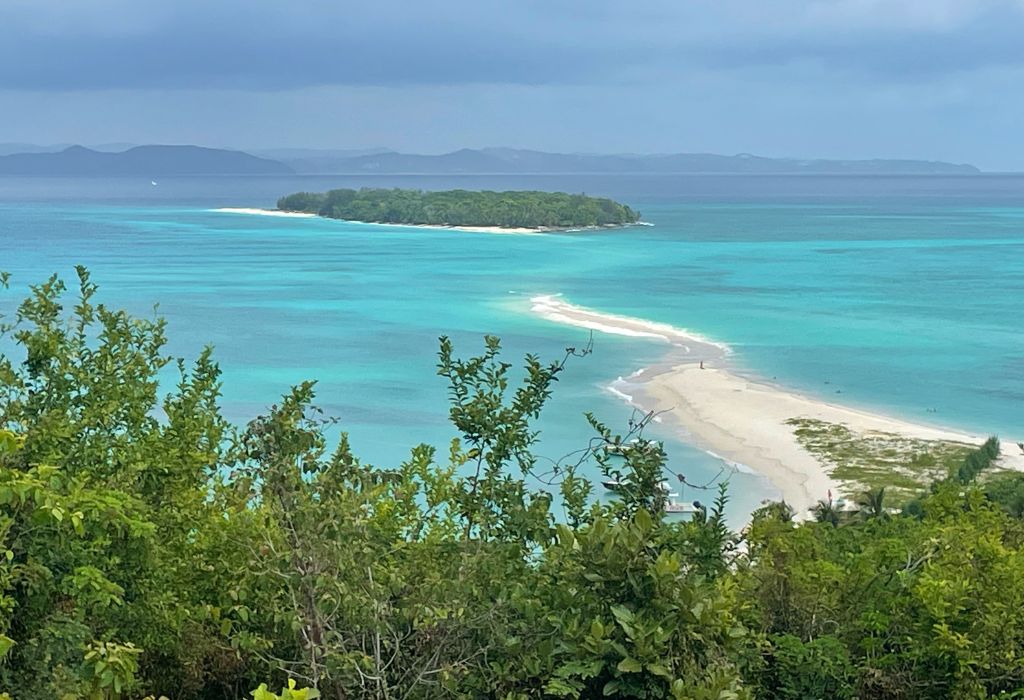
Death is Not the End and Is Celebrated
To the Malagasy, death is not the end. People are sad when someone dies, of course, but they also celebrate when a person becomes a spirit, an ancestor. Many tribes have funerals that involve a lot of dancing.
Some tribes follow a custom called Famadihana, which means ‘the turning of the bones’ and it happens every 7 years or so after a person has died. And is only allowed to happen during the dry season.
During this ceremony, they exhume the bodies of their ancestors from their tombs, re-wrap them in new silks, remember them, tell them the latest news and celebrate their lives. They also carry the bodies around above their heads. It’s a happy occasion involving music, dancing, and often, alcohol.
Taking Pictures
As you would anywhere, especially in a developing nation, please be respectful when taking photographs and always ask if you want to take someone’s picture. General street scenes are fine, but pointing your camera directly at someone without their consent is a no-no.
I found that the Malagasy people almost always said yes, and no one asked for money for a picture, unlike many other places I’ve travelled. Only one person said “no pictures” and that was a lady in a market – I wasn’t even taking a picture of her, just some fruit. She was fine when I showed her the actual picture.
It’s also not culturally appropriate to take pictures of tombs.
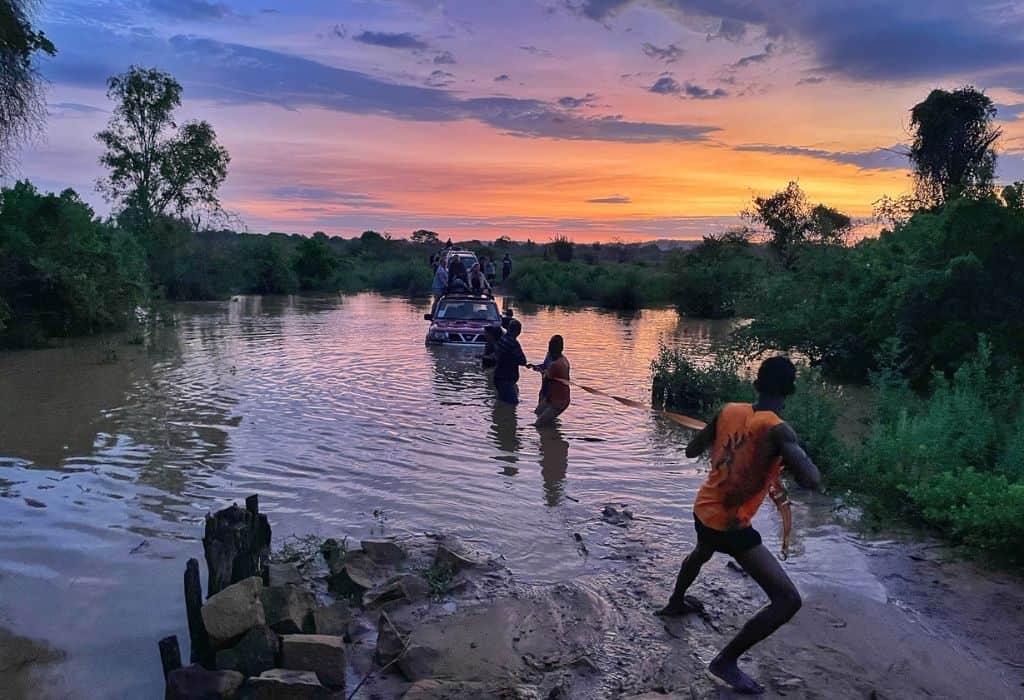
Other Useful Tips for Travelling in Madagascar
It’s All About the ‘Type 2 Fun’
Type 2 Fun is the type of fun that is only really fun when you look back on it. I love Type 2 Fun.
Let me give you an example… I mentioned above about one of our cars getting stuck in the river. Here’s what happened…
When we drove from Morondava to Bekopaka, the roads were horrendous – if you’ve ever watched the Grand Tour Madagascar Special (S4, Ep2) you’ll get a feel for what I mean. Or just watch the Instagram Reel I made!
About 9 hours into our 12-hour journey, one of our cars broke down halfway across a river, filled with water and the group had to climb out through the windows and onto the roof. They were there for a while before they had to wade out of the river, whilst the drivers and some local fellas pulled the car out!
I mean it was hilarious to watch (although I did have a slight – silent – panic to myself about everyone’s electronics getting soaked – luckily they were all fine), especially when a local guy waded into the river to help, with no pants on, holding up his t-shirt so it didn’t get wet but then flashed the guys sitting on the car!
I knew it was fine when I could see everyone taking selfies and once they were back on dry land, we started on the Woodford Reserve whiskey whilst the guys pulled the car out. That bottle of Woodford Reserve became a fully-fledged member of the crew, to be protected at all costs.
It’s a story we’ll all tell for years to come – that’s for sure!
The Journey is the Destination
Madagascar doesn’t really have the big, famous, ‘bucket list’ activities that some other African countries do.
It has, as my friend Katja described it, ‘lots of small gems everywhere’. There are so many cool things to see and do in Madagascar (a lot revolving around lemurs), but really, Madagascar is all about old-school adventure travel.
It’s rough and ready, the ‘highlights’ are few and far between and it has the worst roads I’ve ever come across, but it’s an incredible and magical place to travel for those who dare to visit!
If Madagascar travel was a painting, it would be a Jackson Pollack, not a da Vinci. It’s a bit of a beautiful mess. You never know how it’s going to turn out and that’s the best bit. Go with an open mind and you will be blown away.
If you go expecting perfection… you’re going to be disappointed. It’s difficult and doesn’t always make sense, but it’s wonderful in its own way! It’s very similar to West Africa in that respect.
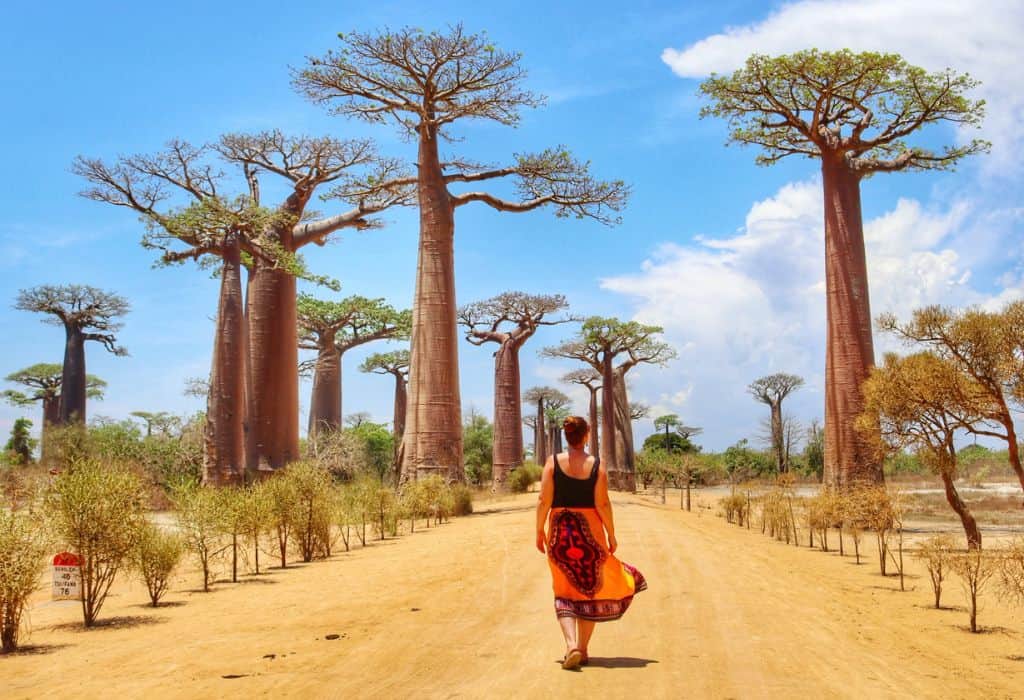
Words Aren’t Always Pronounced the Way They Look
For the first few days in Madagascar, I was pronouncing everything incorrectly.
The letter ‘o’ is often (not always) pronounced ‘oo’ so the word ‘fossa’ (as in the ‘dreaded fossa’, the animal the lemurs are terrified of in the film ‘Magagascar’) is pronounced ‘foosa’.
Anja Community Reserve is pronounced ‘Anza Community Reserve’. The city of Ambositra – you would think is pronounced Am-bo-sit-ra or Am-bo-seet-ra, but it’s actually pronounced ‘Amboostra’. The town of Ranomafana is pronounced ‘Ranumafana’. You’ll get the hang of it.
Deforestation is a Huge Issue, But You Can Help
Madagascar suffers a lot from deforestation. You see it all over the country. This is primarily caused by poverty.
One of the best ways to help Madagsacar is to visit the country and bring in valuable tourism money helps to preserve natural areas and forests for future generations.
You could contribute to various organisations that are actively involved in reforestation and conservation efforts, such as the Eden, SEED Madagascar, or Graine de Vie (Seed of Life). These projects focus on tree planting and collaborating with local communities to develop sustainable livelihoods.
You could also support the WWF or Madagascar National Parks.
Change Your Money Before You Leave
The Ariary is a closed currency so you’ll need to change it before you leave the country. They also do not accept Ariary once you’re through customs when leaving the airport in Antananarivo.
The airport is relatively new and there’s a small shop selling drinks/snacks in the departure lounge, but it only accepts Euros and USD. They are in the process of opening up a bigger shop and restaurant, but they were still closed as of November 2022.
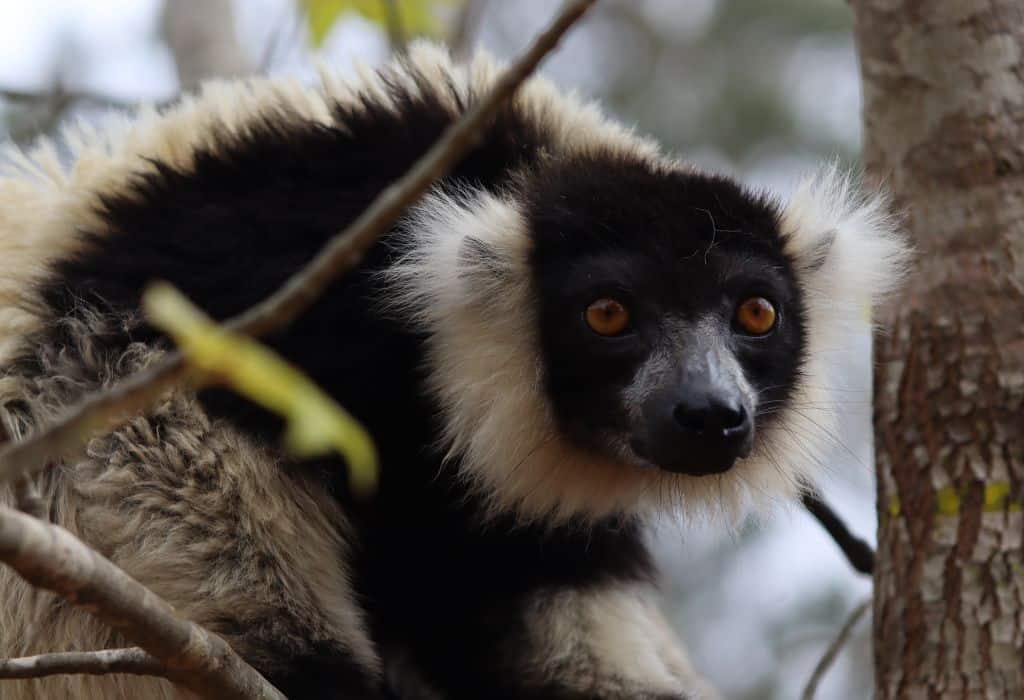
Lemurs Are the ‘Main’ Attraction
One of the main reasons that people visit Madagascar is to see lemurs, which are only found in Madagascar and Comoros.
There are 113 different species of lemur in Madagascar (only 2 in Comoros) and they are really amazing to observe! From the tiny mouse lemurs to the biggest, the indri. And we all know King Julien from the film.
You’ll find lemurs all over Madagascar, but different lemurs are found in different areas. On our trip, we visited tons of national parks, but my favourite places to see them were Anja Reserve (ring-tailed lemurs) and Mitsinjo Reserve (indris).
But… There’s So Much More to Madagascar Than Lemurs
Before I went to Madagascar all I really knew about were the lemurs.
But the country has so much more to offer. There are beautiful beaches (Mosy Iranja – wow), unique culture, amazing food, wonderful scenery and so many adventures to be had. Not to mention all the other amazing animals like whale sharks, dolphins, Omura’s whales, humpback whales, chameleons and fossas!
I’ve written about the best things to see and do in Madagascar here.
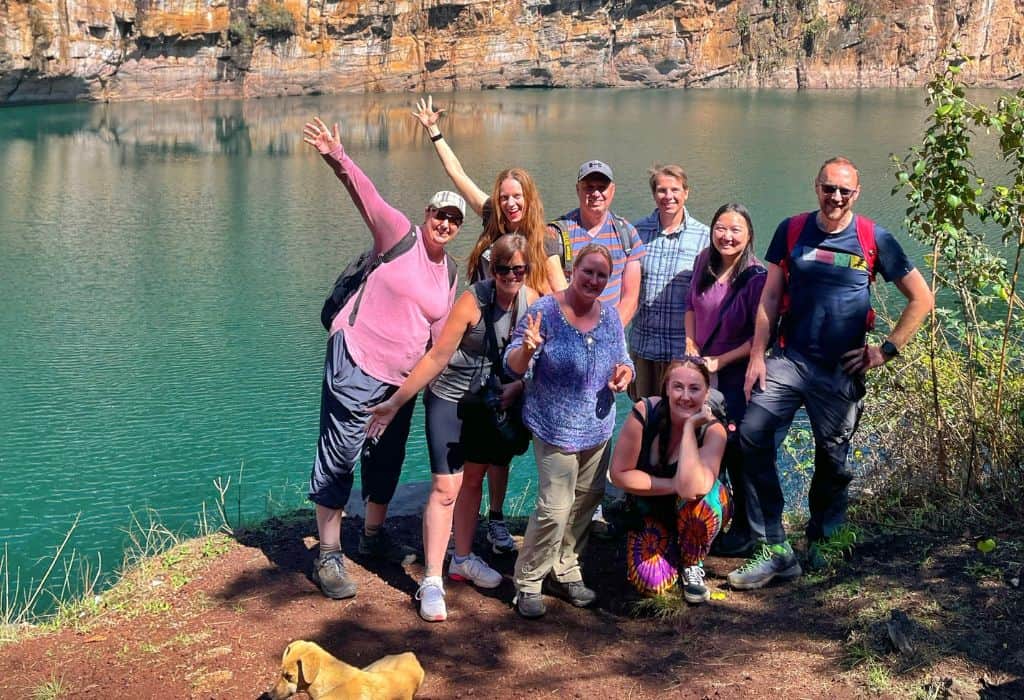
Madagascar is An Incredible Country
Madagascar is one of the most interesting countries I’ve ever visited and I can’t wait to go back.
If you want to go in 2025, I’m running 2 back-to-back Madagascar trips. These trips cover (in my opinion) some of THE BEST highlights of Madagascar:
Other Madagascar posts you might enjoy…
- The Best Things to Do in Madagascar
- The Best Time to Visit Madagascar
- From Africa, With Love – Postcards from Madagascar
- My Top 12 Best African Countries to Visit
If you would like to join one of my Madagascar group trips click here for details.
Any other tips for travelling in Madagascar? Let us know in the comments!
Pin This Post For Later
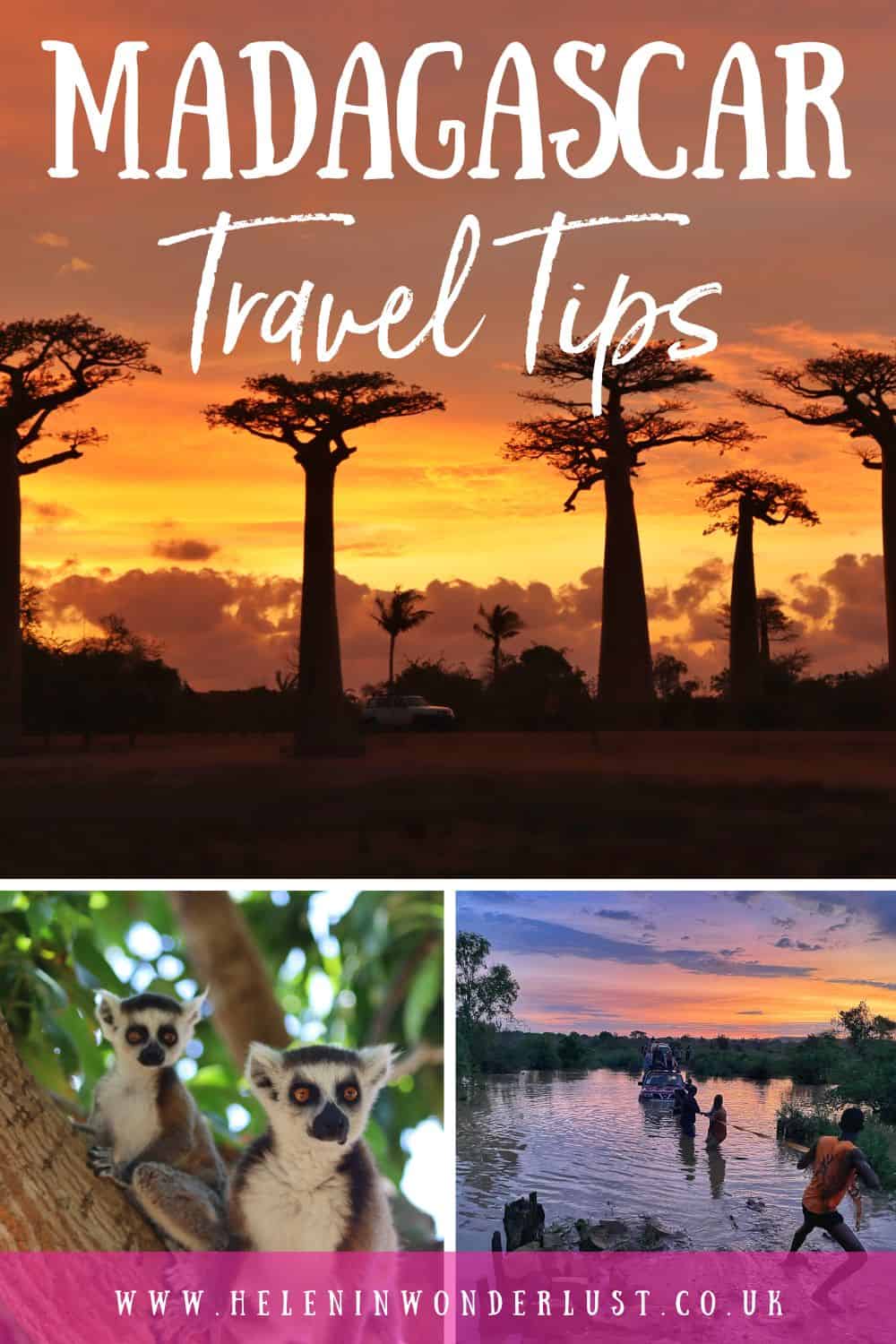
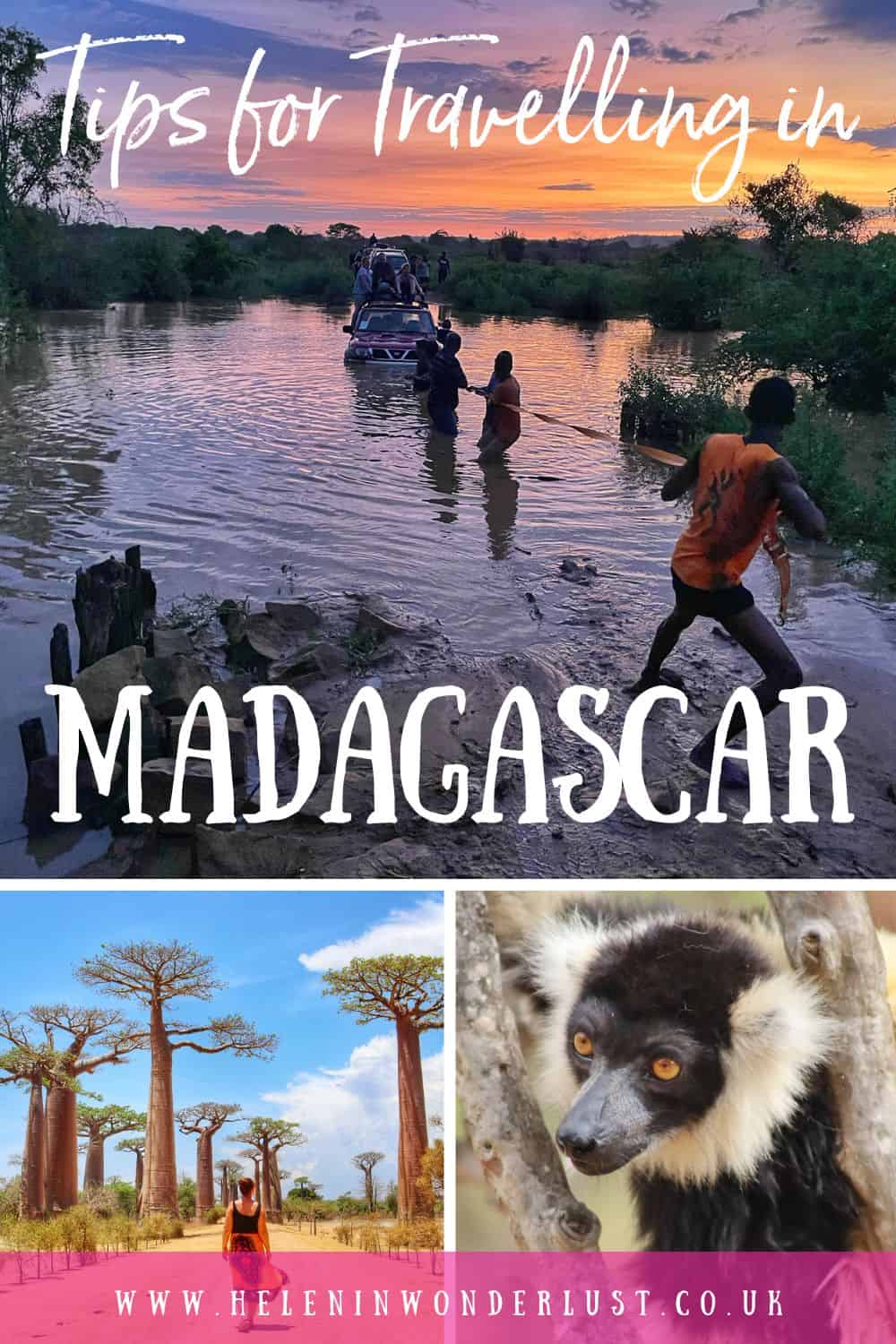

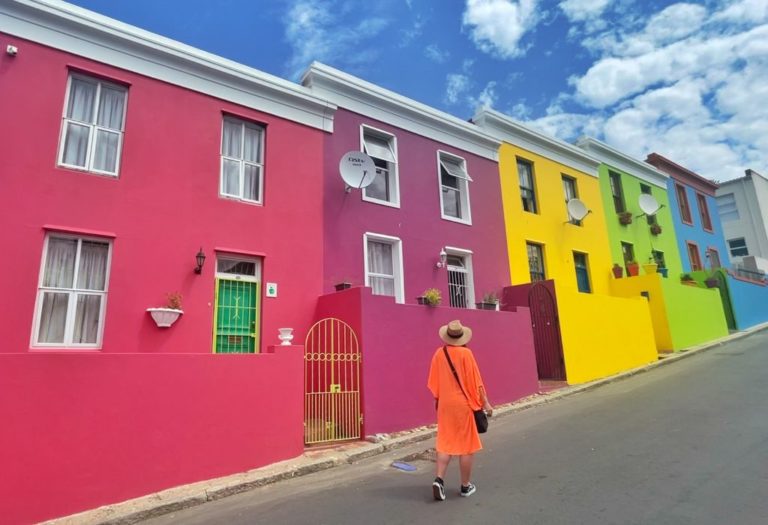
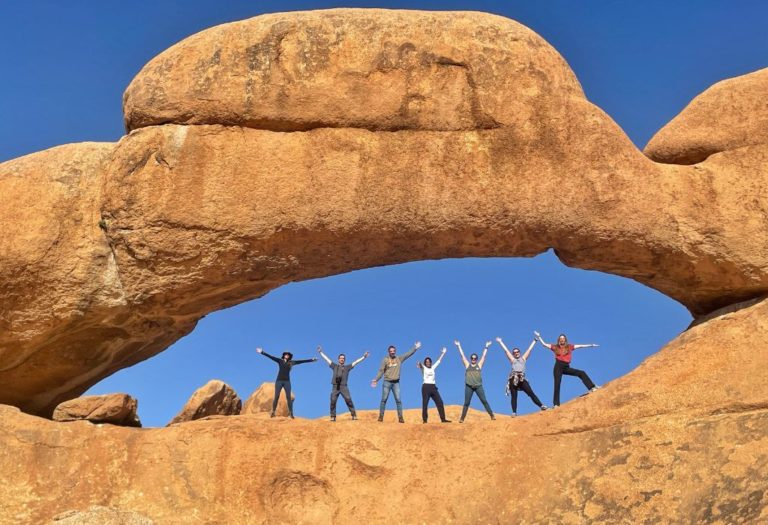
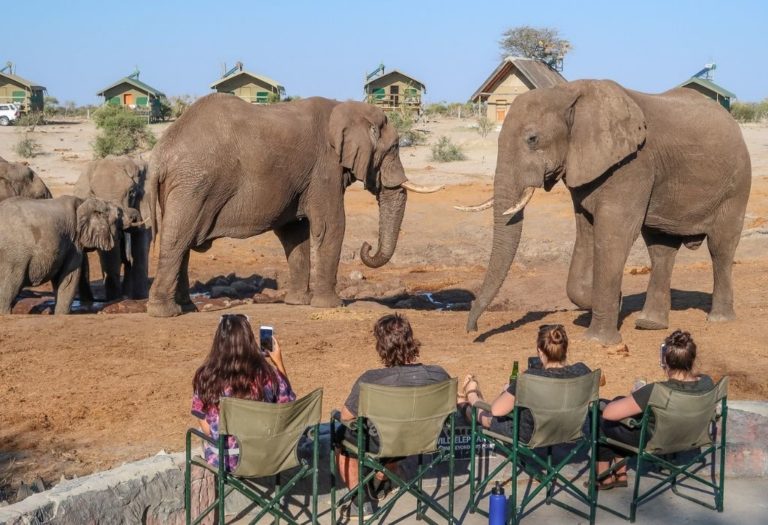
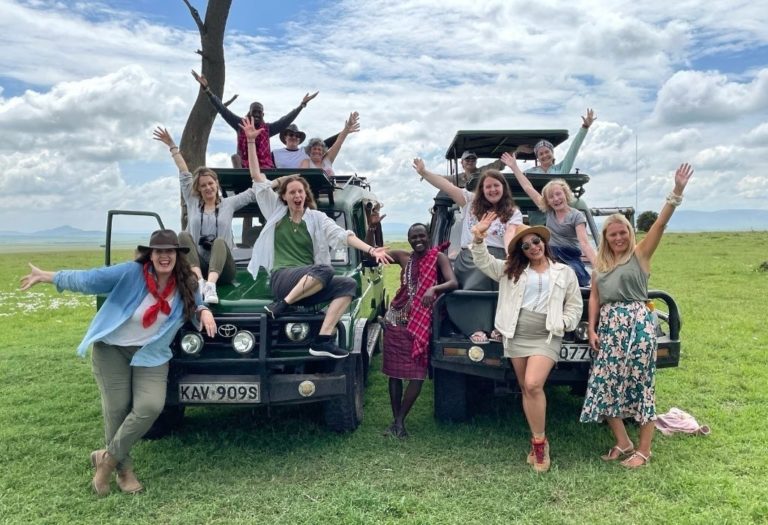
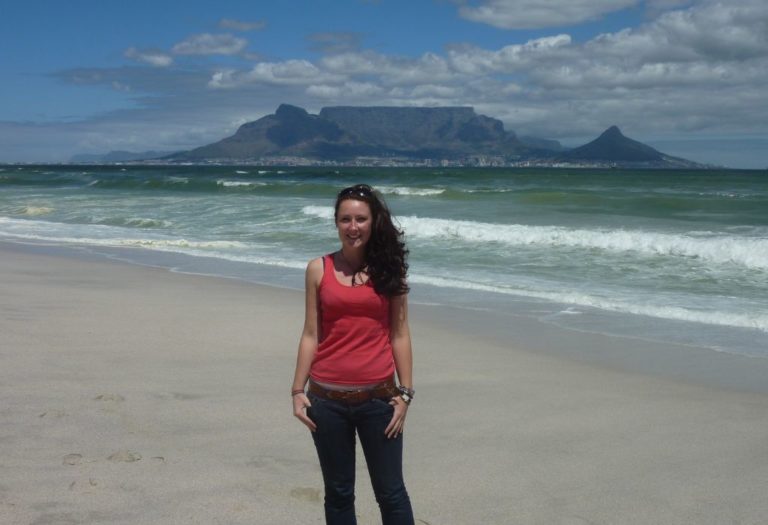
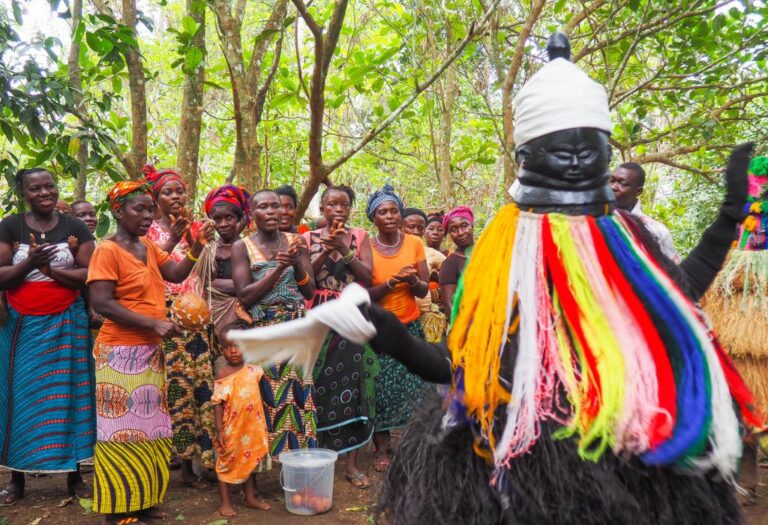
so so so useful
thank you!!!!!!!!
I’m about to go to Madagascar on a group trip (not yours, sorry…maybe next time!) and this has been so helpful in getting a real feel for what to expect – and what to look forward to. Thankyou so much 🙂
No worries, thanks for reading!
Hi.
I am wanting to visit Madagascar in the near future, and have a South African friend who has a resident permit, and possibly if I enjoy it I would like to take up residency there myself. I am an Ocean Skipper and a Rescue Diver and would possibly like to open or run a small already functioning lodge. I am a South African but living in Portugal and would like to move. What sort of employment opportunities are there in the line of Yacht Chartering, Diving and lodge work? I have a Lodge in Portugal together with my Sister and her husband which would possibly be handed over to management or sold.
Are you in the business of assistance for those that want to move to Madagascar as it seems that you are quite ofay with the country?
Hi Owen,
I’m a travel writer and don’t know much about moving to Madagascar or working in the yacht/diving industry, just travelling there.
Your friend who has residency probably knows a lot more than me about how to move there.
I would perhaps visit, speak to some of the people in your industry and then see if you like it. Madagascar isn’t the easiest place to run a business, but some people love it!
Around Nosy Be would probably be your best bet, as that has the bulk of the tourists for the things you mention!
Good luck!
Helen
This was the most irritating blog I’ve ever read. Perhaps FIRST list the things to actually do in Madagascar first before going into essays about irrelevant details like currency and phrases.
This may be the most irritating comment I’ve ever had, as you seem to have misread the title and completely misunderstood the whole point of the post.
You know the post is titled ‘Things to Know Before You Visit Madagascar,’ not ‘Things to Do in Madagascar’, right?
The tips about currency and phrases are quite relevant when preparing for a trip to Madagascar, but I appreciate the inspiration for a future post on ‘things to do in Madagascar’ (update: I’ve written this now).
Oh, and one more ‘thing to know before you visit Madagascar’, or anywhere in Africa, or the world… politeness and kindness go a long way! 🙂
Safe travels!
Helen
Thank you Helen for THIS AMAZING Blog….. I was really sad and a bit mad that *John* whom so ever he is……… had the temerity to call your wonderful extraordinary experiences ……..irritating. Clearly this man , in my humble opinion, is rude , ignorant and deficient in intelligence . He obviously doesn’t appreciate your hard work and dedication in trying to educate and help people like me who wish to travel to Madagascar .
We are considering renting a friends property in January and/ or February 25……would it be possible to join some of your tours? Many thanks and please keep
educating us.
Thank you Anita! 🙂 Appreciate it!
My tours only run around August/September time, but you are welcome to join if you are around then! Here’s the link: https://www.rockmyadventure.com/madagascar-group-tour/
Thanks,
Helen